News
By Carsales staff
Subaru has plugged a gap between mainstream variants of its popular Forester and Outback crossovers with a pair of special edition models.
Based on their respective entry-level models, the 2024 Subaru Forester 2.5i Luxury AWD Special Edition and 2024 Subaru Outback AWD Premium Special Edition are designed to provide additional value with more standard features for a slight price premium.
The Forester Special Edition is just $1000 more expensive (at $39,690 plus on-roads) than the base-level 2.5i AWD but adds black leather upholstery as well as a host of features from the higher-grade 2.5i-S, including a premium dashboard, centre console and higher-quality materials on the door trim.
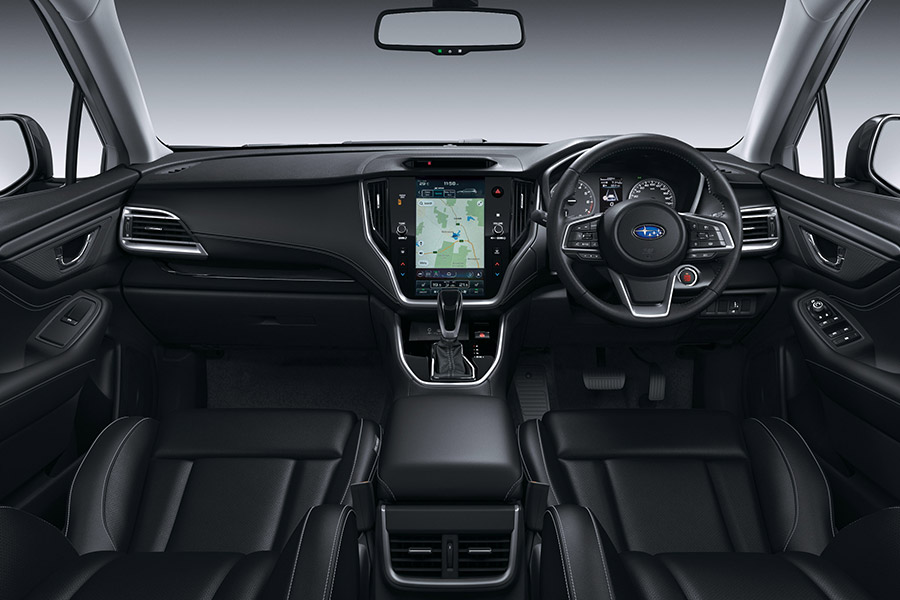
It still retains key features such as 17-inch alloy wheels, X-Mode all-wheel drive, keyless start, dual-zone climate control, an 8.0-inch centre display with smartphone mirroring and a six-speaker sound system.
It’s a similar story with the Outback, except the Premium Special Edition is priced $3500 higher than the eponymous base model (at $47,190 plus on-roads) because it adds higher-grade Nappa leather seat upholstery, heated front and rear outboard seats, sat-nav and a hands-free powered tailgate.
Other kit highlights include an 11.6-inch portrait infotainment system, dual-mode X-Mode, 18-inch alloys, self-levelling LED headlights, dual-zone climate control, smartphone mirroring, six-speaker sound system, keyless entry/start, digital radio and Bluetooth.
No changes have been made to the 2.5-litre flat four-cylinder petrol engine powering either model, nor their symmetrical all-wheel-drive systems or continuously variable transmissions.
“We are delighted to introduce these two special editions which build on the already incredible value these two models represent and offer our customers more options to choose from,” said newly appointed Subaru Australia general manager Scott Lawrence.
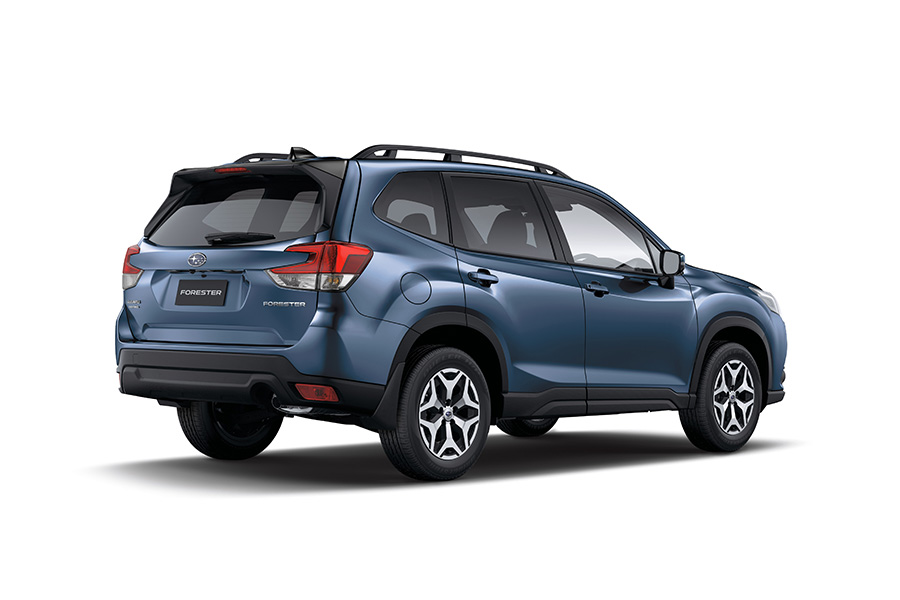
Both new special editions are now available in limited quantities via Subaru’s national dealer network.
How much does the 2024 Subaru Forester cost?
- 2.5i AWD – $38,690
- 2.5i Luxury AWD Special Edition – $39,690
- 2.5i-L AWD – $41,090
- 2.5i Premium AWD – $43,890
- 2.5i Sport AWD – $45,640
- 2.5i-S AWD – $47,140
- Hybrid L AWD – $44,090
- Hybrid S AWD – $50,140
* Prices exclude on-road costs
How much does the 2024 Subaru Outback cost?
- AWD – $43,690
- AWD Premium Special Edition – $47,190
- AWD Sport – $48,190
- AWD Touring – $51,990
- AWD Sport XT – $53,190
- AWD Touring XT – $56,990
* Prices exclude on-road costs
Disclaimer: Images supplied by Subaru.
This article was prepared by an independent author. The information contained in this article represents the views and opinions of the original author, and is based on research carried out by the original author. The appearance of the article on Maxxia's website does not constitute an endorsement of its content by Maxxia in any way. The article has been made available for informational purposes only and should not be taken as advice. While all reasonable care has been taken to ensure that the statements made by the original author in the article are fair and accurate, Maxxia does not guarantee or warrant the accuracy or completeness of this information and will not be liable for, or in connection with, any loss or damage suffered as a result of any inaccuracies, errors or omissions or your reliance on this information. You should independently research and verify information before making any decision in respect of a vehicle.
Reviews
By Bruce Newton, carsales.com.au
The vast majority of Australia is Toyota country. Venture outside the city limits and the automotive landscape becomes a monotonous shade of white four-wheel drives from the Japanese car maker. It’s been that way for decades.
But there’s a newcomer hoping to add some colour – and choice – for off-road adventurers in the form of Chinese brand, GWM, with its new Tank 500, a rugged seven-seat ladder-frame wagon with serious four-wheel drive capabilities and a budget-friendly sticker price.
The 500 is the second model under GWM’s Tank sub-brand for off-roaders following the mid-sized Tank 300 and is powered by a petrol-electric hybrid drivetrain (no diesel here), comes laden with chrome and a long list of standard equipment.
Based on our first drive, it just might be a genuine cut-price alternative to the evergreen – and ever popular – Toyota Prado. Let us explain why.
How much does the GWM Tank 500 cost?
The 2024 GWM Tank 500 is a full-size seven-seat SUV built on a rugged ladder frame chassis with proper four-wheel drive credentials.

It is offered in two model grades that are dictated by the level of equipment rather than technical features, starting with the entry-level LUX that costs $66,490 driveaway and tops out with the flagship Ultra priced at $73,990 driveaway.
The Toyota Prado, which dominates this segment and is about to introduce a wholesale generational change later this year, is its direct competitor based on size, three-row seating, and off-road aspirations.
Other alternatives include ute-based wagons such as the Ford Everest and Isuzu MU-X, and some may even consider it against the full-fruit LandCruiser given the Tank is actually fractionally larger.
Both the LandCruiser and the new Prado are more expensive than the Tank, while the Everest starts cheaper but accelerates up past it when you get into the V6 diesel 4x4s. The MU-X is the budget offering here.
What equipment comes with the GWM Tank 500?
You get a lot for your money with the 2024 GWM Tank 500, which offers an appealing combination of standard equipment and affordable pricing. We’ll stop short of calling it great value at this early stage as there’s no data on reliability and durability available yet.
As the flagship, the Tank 500 Ultra we’re testing here is a burger with the lot. Externally, the body is sprinkled with lots of chrome highlights, plus there’s power-retracting side steps, a panoramic sunroof, roof rails and 18-inch alloy wheels with Giti Xross 265/60 R-spec rubber. Of that lot, only the wheels and tyres are shared with the Lux.
A full-size spare tyre is fitted under a cover on the side opening tailgate – very much like the current 150 Series Prado (the new 250 Series goes to a liftgate).
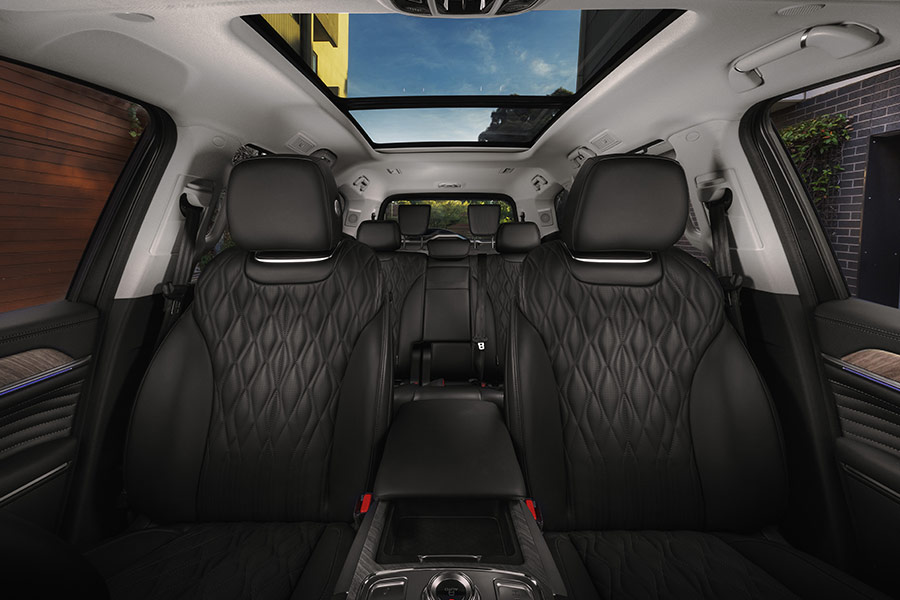
The Ultra also has smart key access with push-button start and Nappa leather-accented seats that include power adjustment (eight-way driver, six-way passenger), heating, ventilation and massage up front. The second-row seats have ventilation and window shades while the third-row seats are power-folding.
Tri-zone climate control, a heated steering wheel, 64-colour ambient lighting, double-layer laminated windows and rear privacy glass are also standard.
The GWM Tank 500 is the first model from the Chinese manufacturer to launch in Australia with a seven-year/unlimited-kilometre warranty, seven years’ roadside assist and seven-year capped-price servicing program. All other GWM Models are 7-5-5.
The Tank 500 is expected to have the same service intervals as its smaller relation, the Tank 300. After a first visit within 12 months/10,000km, they are 12 months/15,000km.
What technology does the GWM Tank 500 feature?
Everything is big inside the Tank 500. The dashboard is dominated by the 14.6-inch colour infotainment screen (one of the largest available in Australia) in the centre of the dashboard, while there’s also a 12.3-inch digital instrument cluster and a head-up display projected onto the windscreen ahead of the driver.
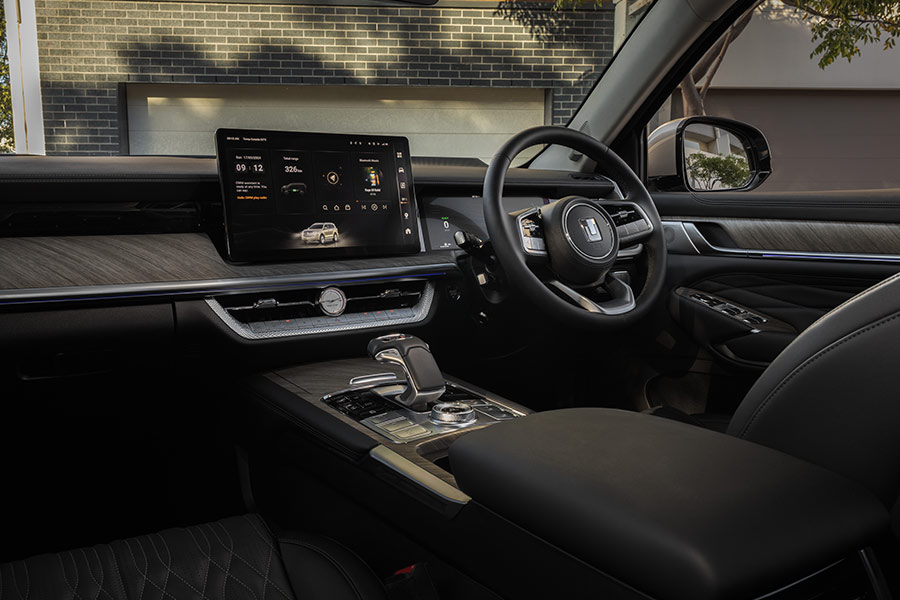
Infotainment features includes wired and wireless Apple CarPlay and Android Auto, Bluetooth connectivity, AM/FM and digital radio and embedded satellite navigation. Audio is played through an Infinity 12-speaker system with active noise cancelling technology, just like your cleaver headphones.
Wireless smartphone charging is included, along with USB-A and USB-C points in the first two rows. Up front there’s also a USB port for a dash cam.
For the first time in Australia, GWM has introduced a smartphone app that includes safety and security features with more stuff under development.
What is the GWM Tank 500 like inside?
Clambering into the cabin of the Tank 500 brings quite a sensory overload.
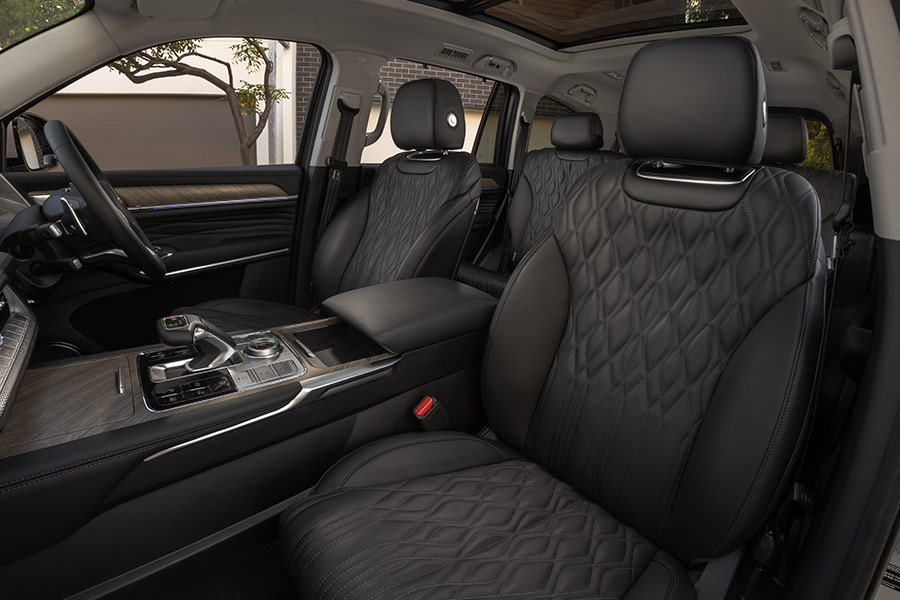
The dashboard is permeated with light grey (fake) wood inserts, chrome highlights, piano black surfaces and soft touch materials, and those oversized screens add a high-tech element that is in stark contrast to the opulent quilted leather trim on the seats. There is a lot going in here.
But give it a minute and the cabin becomes more harmonious and feels relatively well built. It’s not quite up to scratch with Toyota and it will be interesting to see how the Tank’s materials and overall quality age over time.
We recommend you familiarise yourself with the various permutations and operations of the central screen and what happens within its various functions because there’s a lot to take in here. You have to drill into the touchscreen to adjust audio (or use steering wheel buttons or voice control), but not the air-conditioning, which has its own set of permanent controls located on the central stack just below a distinctive analogue clock. You can select one of a number of views for the instrument cluster too.
The quilted leather seats are not only attractive to look at but provide plenty of support and comfort. However, the driver’s seat does not slide far enough forward for shorter drivers, but at least there’s power reach and rake adjustment and no shortage of foot space.
Row two has a 66/33 split-fold and slides and reclines with plenty of space, so 180cm-tall people should be seated comfortably in both the first and second rows.
The powered third row is really for the kids. There are two concerns here: the easiest way to access the rearmost seats from row two is via the driver’s side – the traffic side. It would be safer to access through the tailgate if you can. Mind you, with the wheel attached, the tailgate is a hefty device to open and close.
Also, when all three rows are in place there is very little luggage space left over: just 98 litres. That expands to 795 litres with two rows in place and 1495 litres when only the front seats are in use.
There are air-con vents and storage nooks and crannies spread through all three rows including sizeable door bins. The second-row passengers also get access to their own set of climate controls.
But this doesn’t have the interior functionality and storage ingenuity of something like a Land Rover Discovery or Defender.
How safe is the GWM Tank 500?
In something of a rarity among auto brands, GWM Australia is confident of achieving a maximum five-star ANCAP safety rating for the 2024 GWM Tank 500 based on current protocols.
Testing by the safety authority is only just getting underway and we’ll find out in a few months.
To meet those requirements, the Tank 500 is fitted with a comprehensive suite of driver assistance systems including autonomous emergency braking (AEB) with pedestrian and cyclist detection and adaptive cruise control with lane centring supported by a phalanx of aids designed to keep you in your lane, warn you if you’re veering out of it, dodge stuff entering your lane and help you change lanes if you want to.
Other safety assistants include rear collision warning and rear cross traffic braking, traffic sign recognition, door opening warning, driver fatigue monitoring and traffic sign recognition.
The Tank 500 also comes with front, front-side, curtain, and front-centre airbags. Multiple cameras stitch together into a 360-degree display for parking and low-speed manoeuvres, supported by 12 parking sensors with reverse and auto parking assist.
The headlights are LED with auto high beam. Two ISOFIX and three top tether strap points secure child seats.
What powers the GWM Tank 500?
In other markets, the Tank 500 is offered with a choice of powertrain options, including a twin-turbo V6 petrol and a plug-in hybrid. But GWM has decided to offer just one engine choice in Australia, with a regular parallel petrol-electric hybrid for now.
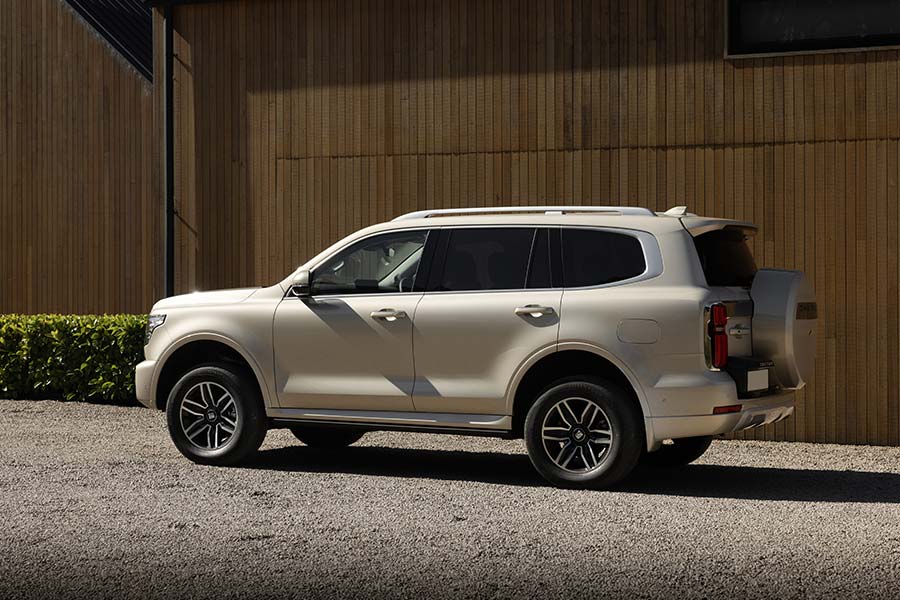
The drivetrain links a 180kW/380Nm 2.0-litre four-cylinder turbo-petrol engine tuned to the efficiency-chasing Miller combustion cycle with a 78kW/268Nm e-motor tucked into the transmission tunnel and a small 1.76kWh battery pack under the floor.
The combined outputs are claimed to be 255kW and 648Nm. The torque number is interesting because it is the max outputs of the petrol engine and e-motor added up. Often the combined number is smaller because peak outputs are produced at different parts of the respective rev ranges. Toyota doesn’t even publish a combined torque figure for hybrids.
There are nine different driving modes to tailor the powertrain for unique on- and off-road conditions but just one choice of transmission with a GWM-developed nine-speed auto and a BorgWarner transfer case with low-range. There are also front and rear locking diffs, wheel-locking tank turn, crawl control (off-road cruise control) and hill descent and ascent control.
How fuel efficient is the GWM Tank 500?
The 2024 GWM Tank 500 has a claimed average fuel consumption of 8.5L/100km, with the cheapest 91 RON unleaded fuel deemed acceptable.
It also has three-level regenerative braking to restore battery capacity.
Combine that with the 80-litre fuel tank and the 500 looks like it could generate a pretty decent range between fuel stops.
At this point though we’re just not quite sure how achievable that theoretical fuel consumption claim is. On the launch drive, the trip computer swung between 12 and 14L/100km, which cuts range dramatically if accurate. And that’s without taking into account stuff like towing or going off-road in low range.
It backs up GWM’s claim that the hybrid system is more about increasing performance than reducing economy.
What is the GWM Tank 500 like to drive?
Diesel is generally the default choice for large off-road wagons, so it feels a little weird to quietly potter around in the GWM Tank using electrical power alone.
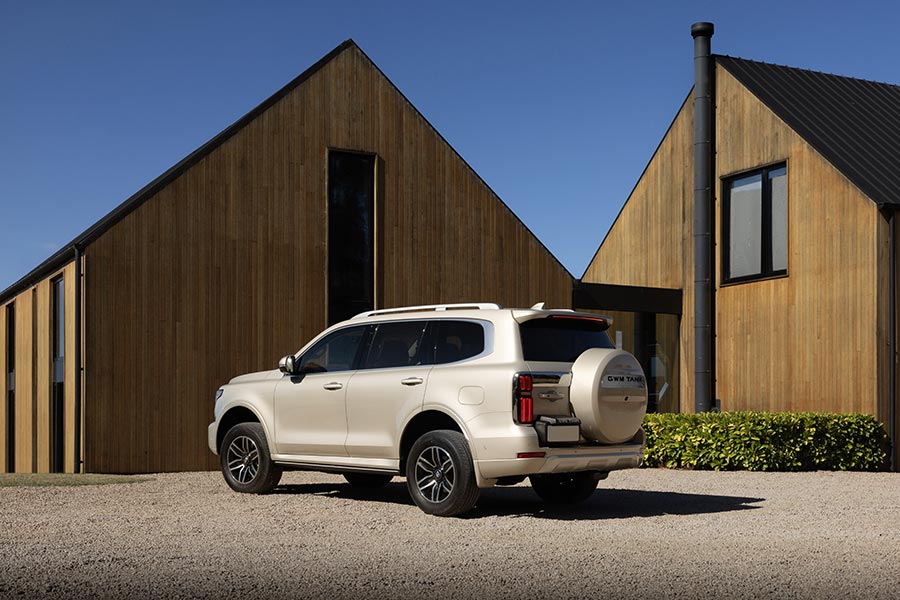
Not surprisingly considering its weight and the small capacity battery, that doesn’t happen often or last very long, but even when the petrol engine inevitably chimes in the noise and vibration is still less than traditionally associated with a diesel. Clatter be gone!
In that regard, the drivetrain is a bit of a chameleon. It is very clearly focused on economy in the dull Normal mode, becoming much more alert and responsive when switched to Sport. This is one multi-mode system that isn’t just a placebo.
GWM makes a big deal about how the nine-speed auto is its own design and that the team leader on the program used to work for Mercedes-Benz. Well, he did his job because there is no obvious clunking, flare, or lag in any mode, or when shifting manually using the steering wheel paddles.
The Tank 500’s big challenge based on our previous experience of Chinese vehicles (and GWM models specifically) is the way it steers, handles, and rides.
Well, in the case of the Tank 500, GWM seems to have a decent handle on ladder-frame vehicles. It’s certainly better than some of its monocoque-based vehicles like the Haval Jolion and H6 SUVs.
The steering is tight and accurate, the body control is quite decent for such a big, tall, and heavy vehicle, and apart from some typical ladder-frame shimmy across potholes and lateral movements and some evidence of firmness from the live-axle rear-end, the ride is comfortable as well.
That’s all at cruising speeds on some quite bumpy and winding country bitumen roads. When the going got tighter and more pressure was put on the Tank 500 there was lots of front-end push and roll. Add in some rain and the Giti tyres struggled to hook up on the greasy surface. Let’s just say the Tank 500 likes relaxed, rather than enthusiastic, driving.
Activating the lane keeping systems and the like was approached with some trepidation after our poor impression of the smaller Tank 300. But happily, there was no sign of that in the 500 during our first drive.
I still prefer the lane centring to be switched off because there were some impulses channelling their way through to the steering wheel that were too abrupt. But it wasn’t egregious and tuned within the bounds of acceptability, which is quite a step forward.
But there were still annoyances. The primary one was the car regularly warning me there was a curve approaching. I’m not sure which system controlled that function or why it picked certain road situations to pipe up. Another thing to investigate further later.
Anyway, I think we figured out a way to switch it off because it disappeared after some jabbing at the touchscreen.
How good is the GWM Tank 500 off-road?
Sadly, our off-road drive of the 2024 GWM Tank 500 was curtailed by monsoonal rain that burst just as we were about to hit the rough stuff and engage low range. It was a case of better safe than bogged!
However, we were in the situation during the day’s driving to witness the Tank 500 negotiating some seriously technical tough off-road sections and it did so without getting beached or ripping its guts out.
The capabilities are backed up by off-road info in the screen that includes tyre pressure monitoring, compass, pitch and roll, atmospheric pressures, and see-through cameras so you can see what you are clambering over.
Given what we saw and the specification, the signs are very good for the Tank 500 as a true off-roader capable of competing with the Prado, Everest, and Co.
Like the fuel consumption, we’ll reserve judgement until we spend more time behind the wheel.
How much can the GWM Tank 500 carry?
So, let’s crunch some numbers about the 2024 GWM Tank 500.
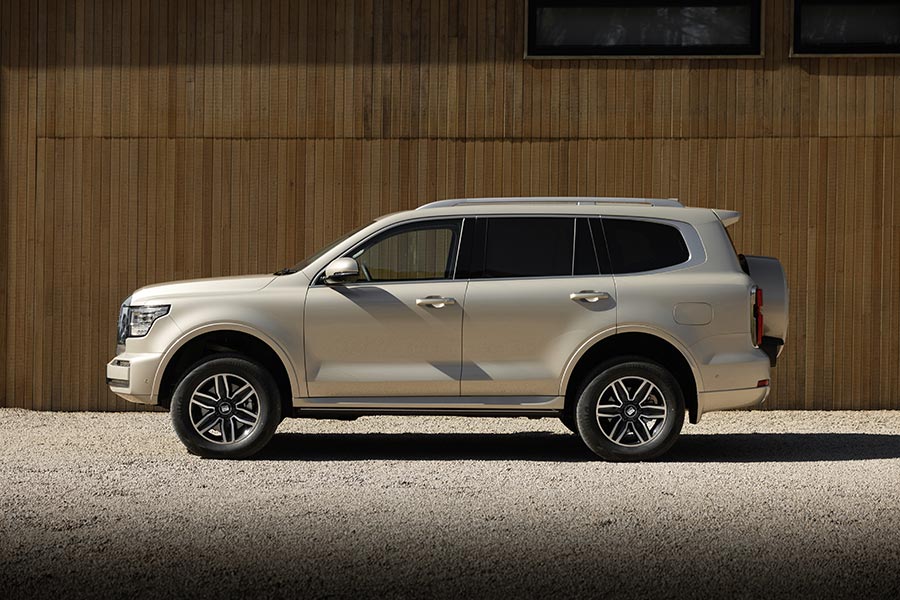
Firstly, the Tank 500 is a big machine. It measures 5078mm long, 1934mm wide, 1905mm high and has a 2850mm wheelbase. The outgoing 150 Series Prado’s equivalent numbers are 4995mm, 1885mm, 1890mm and 2790mm. So, the Tank is a bigger vehicle.
It’s also significantly heavier, weighing in at a LandCruiser-rivalling 2605kg, versus a maximum 2350kg for the 150.
That then leads to payload and towing numbers.
The Tank 500 has a 790kg payload, a 3395kg gross vehicle mass (GVM) and a 6705kg gross combined mass (GCM). The maximum braked towing capacity is 3000kg, and when you add up all the figures the adjusted payload comes out at a usable 490kg.
Do the same calculation for the 150 Series Prado with its identical 3000kg braked towing capacity and the max payload is 340kg. The Tank is looking good.
Of course, the 250 Series Prado is only months away and we don’t have all the relevant numbers for that – only that it will bump up to a 3500kg towing capacity.
Should I buy a GWM Tank 500?
The 2024 Tank 500 makes a good first impression.
But we’re talking about a substantial investment in a vehicle that is designed to transport up to seven people safely and competently across wild and rugged terrain.
We simply don’t know yet if the Tank 500 will hang together in such challenging circumstances.
Toyota 4x4s do, and that’s why they are so popular, and people are prepared to pay a premium for them. Tank is at the start of a journey Toyota’s been on for decades.
Undoubtedly, the price and equipment equation the Tank 500 offers will attract an audience and the seven-year warranty will provide reassurance.
The drive experience also appears competent and that’s encouraging.
But we need more time with the Tank 500 before it can genuinely drive into Toyota territory.
2024 GWM Tank 500 Ultra at a glance:
Editor’s Rating: 7.9/10
| Price: $73,990 (drive-away) |
Transmission: Nine-speed automatic |
| Available: Now |
Fuel: 8.5L/100km (ADR Combined) |
| Powertrain: 2.0-litre four-cylinder turbo petrol-electric |
CO2: 199g/km (ADR Combined) |
| Output: 180kW/380Nm (electric motor: 78kW/268Nm) |
Safety Rating: Not tested |
| Combined output: 255kW/648Nm |
Disclaimer: Images supplied by GWM ANZ.
This article was prepared by an independent author. The information contained in this article represents the views and opinions of the original author, and is based on research carried out by the original author. The appearance of the article on Maxxia's website does not constitute an endorsement of its content by Maxxia in any way. The article has been made available for informational purposes only and should not be taken as advice. While all reasonable care has been taken to ensure that the statements made by the original author in the article are fair and accurate, Maxxia does not guarantee or warrant the accuracy or completeness of this information and will not be liable for, or in connection with, any loss or damage suffered as a result of any inaccuracies, errors or omissions or your reliance on this information. You should independently research and verify information before making any decision in respect of a vehicle.
News
By Carsales Staff
Big changes are coming for Hyundai’s popular small i30 hatchback.
The South Korean car maker has revealed details of a facelift for the five-door ahead of its arrival in Australian showrooms later this year.
In what is the second major update for one of the country’s top-selling cars, the revisions are more than skin deep as it will herald a significant switch in production source for the Australian market with the new model set to be shipped from Hyundai’s Czech Republic factory rather than Korea.
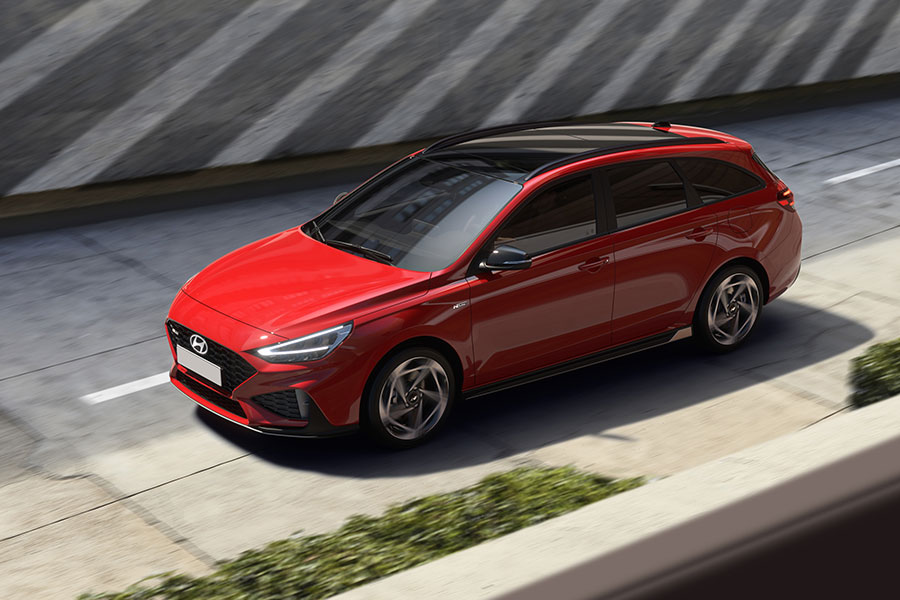
The changeover has created a gap in availability for the i30 locally as production of the outgoing model has already been wrapped-up. But the waiting will be worth the time as the updated model will likely bring new technologies, including the potential for more fuel-efficient engine options and improved safety systems.
As the images highlight, the subtle facelift borrows design cues from the high-performance i30 N to sharpen its aesthetic, including more aggressive front and rear bumpers, revised (and now LED) headlights, N-style DRLs and a new black grille finish.
The standard range of alloy wheels has also been refreshed, along with the tail-light graphics.
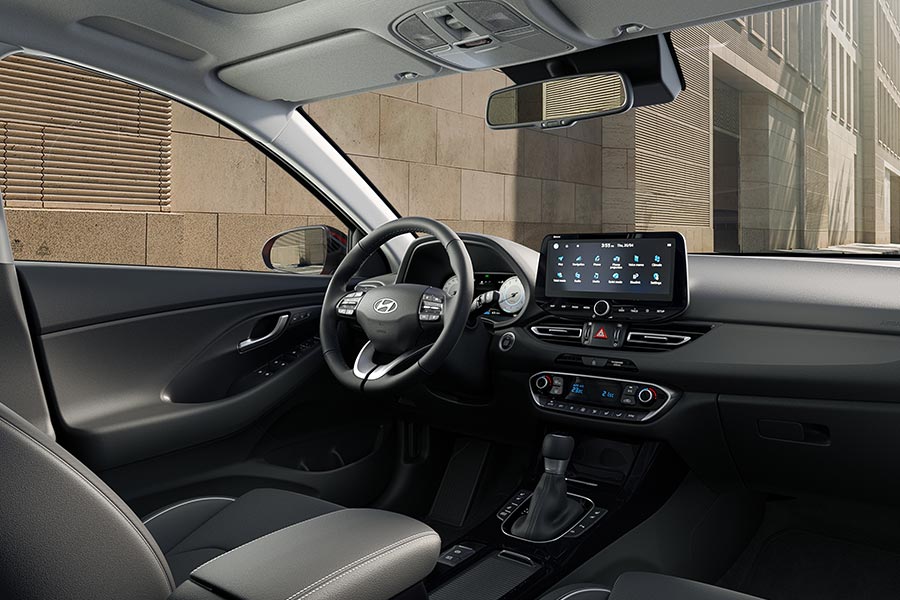
Cabin revisions include new dash and centre console trim, plus a larger 10.25-inch digital instrument cluster for high-end variants.
Over-the-air (OTA) update capability has been added to variants offering sat-nav, while all grades score lane following assist, intelligent speed limit assist and the rear occupant alert.
Many of the updates will also apply to the i30 N hot hatch, which has been spotted testing in Europe and Korea and is expected to be revealed soon and go on-sale shortly after the regular models arrive around mid-year.

Full local details of the Australian i30 line-up are yet to be announced, but Hyundai is expected to continue with the familiar array of i30, Active, Elite, N-Line and N-Line Premium model grades. However, the switch to European sourcing – and additional features – are likely to see prices increased over existing models.
Entry-level versions are likely to feature a new, fuel efficient 1.5-litre turbo petrol four cylinder while higher grade models will feature the 1.6-litre turbo-petrol powertrain from the current N-Line. Mild-hybrid tech is also being introduced in Europe.
The current range starts from $24,000 plus on-road costs and tops out at $37,300 for the i30 N-Line Premium DCT – or $53,700 plus ORCs if you include the i30 N portfolio, which will likely be shown in updated form in the coming weeks, followed by a revised version of the pint-sized i20 N hot hatch.
Disclaimer: Images supplied by Hyundai.
This article was prepared by an independent author. The information contained in this article represents the views and opinions of the original author, and is based on research carried out by the original author. The appearance of the article on Maxxia's website does not constitute an endorsement of its content by Maxxia in any way. The article has been made available for informational purposes only and should not be taken as advice. While all reasonable care has been taken to ensure that the statements made by the original author in the article are fair and accurate, Maxxia does not guarantee or warrant the accuracy or completeness of this information and will not be liable for, or in connection with, any loss or damage suffered as a result of any inaccuracies, errors or omissions or your reliance on this information. You should independently research and verify information before making any decision in respect of a vehicle.
Reviews
By Alexandra Lawrence, carsales.com.au
Toyota has been pushing the barrow for hybrid technology almost on its own for nearly 30 years now. And now it is pushing the boundaries of small soft roaders – a category it also invented with the original RAV4 back in 1994 – with the second-generation of its funky C-HR, which becomes the latest model line to move to a hybrid-only range.
Now built in Turkey, the all-new C-HR introduces a striking new design, more infotainment and safety technologies and a significantly higher entry price, by around $11,000.
For some, that will be hard to look past. But there’s plenty of other reasons why the C-HR can’t be ignored. Here’s why.
How much does the Toyota C-HR cost?
Toyota has repositioned the second-generation C-HR as a premium small SUV, with a price to match.

Where the original model arrived to fill a void below the RAV4 that has grown with every model upgrade, that entry-level city-sized position has since been filled by the Yaris Cross, leaving the C-HR in no-man’s land…until now.
By virtue of the fact that Toyota has decided to only offer the second-gen model exclusively powered by a hybrid powertrain (while also announcing similar plans for the Corolla hatchback, Yaris city car and Camry sedan), entry into the C-HR line-up has increased by more than $10,000 over its predecessor.
The Japanese brand has also expanded the model line-up too, increasing the variants from two to three, starting at $43,000 plus on-roads for the base-model GXL, rising to $49,990 (plus ORCs) for the mid-spec Koba and topping out at $54,990 (plus ORCs) for the flagship GR Sport.
That puts a large wedge between the C-HR and key rivals like the Mazda CX-30 (from $33,140 plus ORCs), Hyundai Kona (from $32,000 plus ORCs) and Volkswagen T-Roc (from $39,790 plus ORCs).
But Toyota does have other options for small SUV shoppers with the Corolla Cross range retaining the choice of petrol and hybrid models (from $33,890 to $50,030 plus ORCs).
Toyota expects the vast majority of buyers (about 70 per cent) to choose the mid-spec Koba variant, with 20 per cent stumping up for the GR Sport and just 10 per cent opting for the base GXL.
Importantly, a long list of standard equipment on all grades makes those prices a little more palatable.
What equipment comes with the Toyota C-HR?
Even at base level, the 2024 Toyota C-HR GXL is fitted with 17-inch alloy wheels, LED headlights and daytime running lights (DRLs), heated exterior mirrors, keyless entry with push-button start, rain-sensing wipers, and dual-zone climate control.
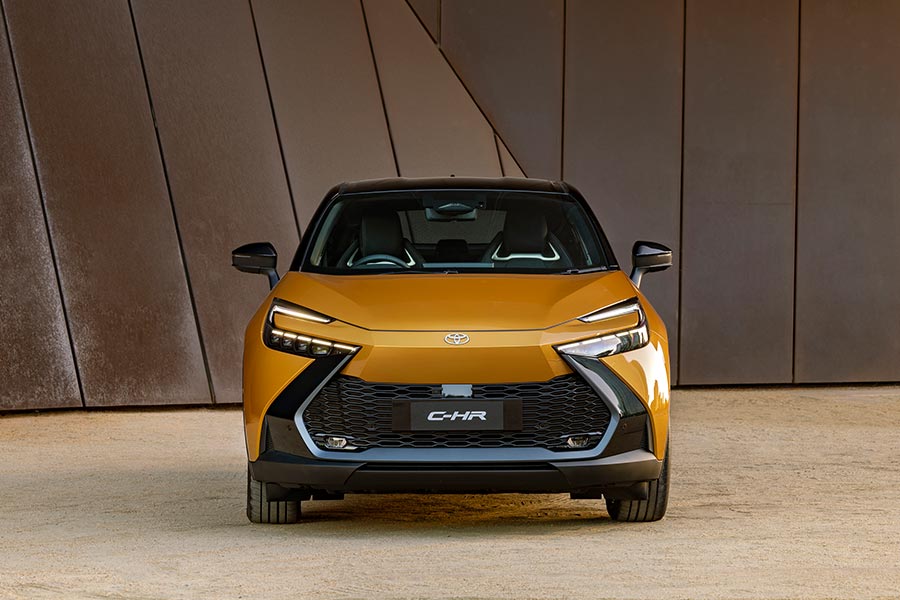
The Koba we’re testing here gets larger two-tone 19-inch alloy wheels, bi-LED headlights with auto-levelling, LED front fog lamps, cornering lamps, a powered tailgate, unique front grille, tinted rear windows, sporty fabric/suede-like front seats with heating, ambient interior lighting, and a powered driver’s seat with memory.
The flagship GR Sport brings the only major mechanical upgrade with all-wheel drive, as well as adding gloss black 19-inch alloys, a GR Sport grille, black exterior trim details, leather-appointed/suede-like sports seats, a heated steering wheel, alloy scuff plates and GR Sport floor mats.
The GXL is available in six colours: Glacier White, Frosted White Pearl, Graphite metallic, Stunning Silver metallic, Ink mica metallic and Emeraldine mica metallic, while the Koba or GR Sport can also be optioned with a striking two-tone paint scheme.
Toyota charges an additional $775 to paint the roof black, while you can opt for that gloss black paint to be extended to the rear half of the car for an additional $1550.
Tick the options box for a panoramic roof (which automatically comes with the two-tone paint scheme) and it’ll be another $1150.
All C-HR models are backed by Toyota’s five-year/unlimited-kilometre warranty, with capped-price servicing offered during the first five years (or 75,000km) at $200 per service – due every 12 months or 15,000km.
What technology does the Toyota C-HR feature?
There is value in the price rise for the 2024 Toyota C-HR as all models come equipped with an array of new technologies and conveniences.
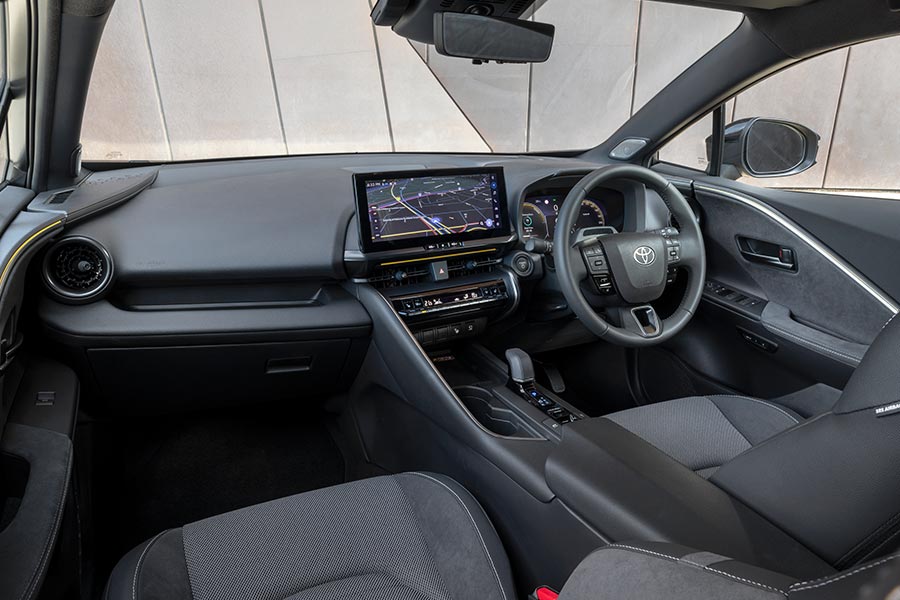
A larger 12.3-inch touchscreen is standard across the range, bringing embedded and cloud-based navigation, Android Auto, wireless Apple CarPlay, Bluetooth, and digital radio.
The infotainment system is intuitive and easy to use, while physical climate control buttons are situated on a control panel just below, making adjustments on the move simple to execute.
The driver is also treated to a fully digital instrument cluster, while the sound system varies from a six-speaker unit in the GXL to a premium nine-speaker JBL system in Koba and GR Sport.
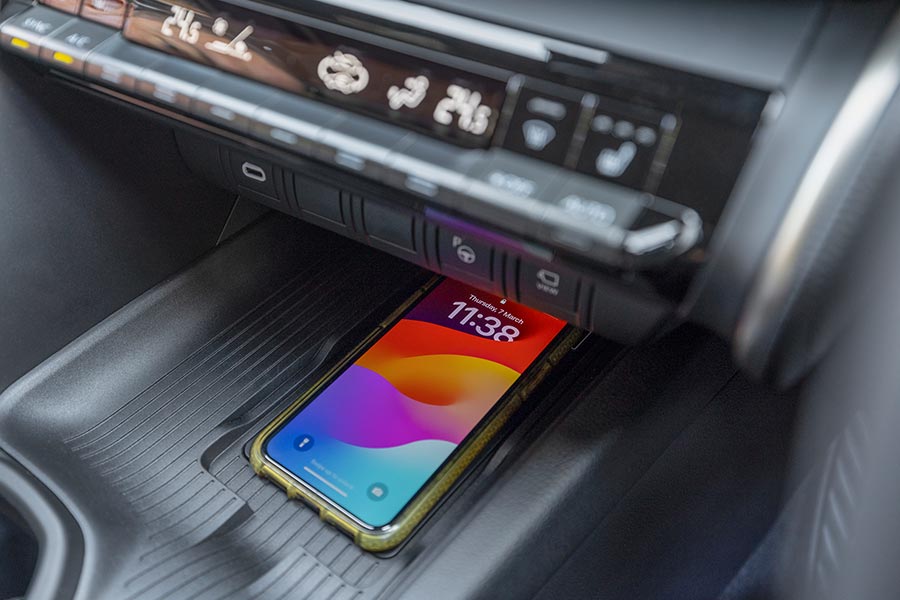
Koba and GR Sport also feature a wireless phone charging pad, along with a digital rear-view mirror – as seen in the larger RAV4 – which comes in handy if you managed to squeeze three adults into the rear seat and can’t see out the small rear window.
Toyota Connected Services also makes its way into the C-HR for the first time, offering a free 12-month subscription (then from $9.95 per month). It brings the ability to connect your vehicle via your smartphone to access real-time information such as fuel level, vehicle location, and more.
What is the Toyota C-HR like inside?
The original Toyota C-HR introduced a new exterior design language from Toyota which wasn’t reflected very well in the cabin. It looked both fussy and out of date.
But the new model changes that with an interior design that is simpler and more modern, which helps with the premium vibe.
In mid-spec Koba trim, the door cards feature soft suede-like inserts – even if the top half is still hard plastic – and the leather-appointed steering wheel feels lovely underhand. The smaller gearshift makes the cabin feel more spacious and there are plenty of storage options up front.
For those hopping out of a first-gen C-HR, the steering wheel is just as busy and button-heavy as before, but it’s now laid out in a simpler fashion that makes it easy to navigate.
A larger central touchscreen and fully digital instrument cluster moves the new C-HR along, while the addition of connected services will be a win for tech-heads.
As before, the second row is a tight fit for adults and is best left to children or small teenagers. A pair of adults in the outboard seats should be fine on shorter trips, however the curving roofline hinders headroom, and there’s very little in the way of amenities.
There’s no centre arm rest or air vents and only a single USB-C port is provided at the rear of the centre console of the Koba and GR Sport (not on GXL). The rear door pockets really only have room for a small cup.
Likewise, if you’ve got taller people in the front row, you’ll struggle for legroom in the rear seat.
Meanwhile, the front-wheel drive Koba tested here offers a decent 388 litres of boot space (or 1155L with the rear seat folded), while the GR Sport AWD offers 362L (extending to 1134L).
How safe is the Toyota C-HR?
Similarly, the new-generation 2024 Toyota C-HR receives a significant upgrade in safety equipment over its predecessor.

All three model grades are equipped with autonomous emergency braking (AEB) with detection for pedestrians, motorcyclists, and cyclists (daytime only), as well as oncoming vehicles at intersections.
There’s also rear cross traffic alert, blind spot monitoring, a driver fatigue monitoring system, lane trace assist and departure warning, emergency steering assist, speed sign recognition, safe exit assist, parking sensors at both ends, a panoramic view monitor and park assist.
Adaptive high beams are fitted to the Koba and GR Sport, leaving the GXL with a less-advanced (but still handy) automatic high-beam set-up.
The adaptive cruise control system now brings four pre-set following distances, up from three, while the upgraded AEB camera system is said to have a wider and deeper range of collision detection.
In the event of a collision, there are 10 airbags protecting the vehicle occupants.
The new C-HR is yet to be crash-tested by either Euro NCAP or ANCAP, but a maximum five-star safety rating is expected.
What powers the Toyota C-HR?
There are two powertrain options in the hybrid-only 2024 Toyota C-HR range, both of which utilise Toyota’s latest fifth-generation hybrid technology.
Entry-level GXL and mid-spec Koba grades are fitted with a revised version of the front-wheel drive 1.8-litre petrol-electric set-up used in the first-generation C-HR, albeit with a range of upgrades said to make it more efficient and powerful.
Meanwhile, the GR Sport gets a more powerful 146kW (peak combined) set-up, made up of a 2.0-litre four-cylinder petrol engine and a pair of electric motors. It’s also the only C-HR variant to get Toyota’s eFOUR all-wheel drive system.
In the Koba tested here, peak combined power is 103kW, courtesy of its 72kW/142Nm (at 3600rpm) 1.8-litre four-cylinder petrol engine and front-mounted 70kW electric motor.

Of the upgrades, Toyota details a smaller and lighter hybrid transaxle in GXL/Koba which it claims offers improved noise, vibration, and harshness (NVH) levels, while the petrol 1.8-litre has been “thoroughly refined”.
Both powertrains now use a lighter lithium-ion battery in place of the first-gen C-HR’s nickel-metal hydride battery, and every C-HR is fitted with a continuously variable transmission (CVT).
There’s a plug-in hybrid version of the C-HR in Europe, but it’s currently not on the agenda for our market. Toyota Australia’s vice-president of sales and marketing, Sean Hanley, said that if demand is high enough, the company will consider bringing the PHEV here.
How fuel efficient is the Toyota C-HR?
There’s surprisingly little benefit with the hybrid system when it comes to fuel consumption for the new Toyota C-HR.
Both front-wheel drive versions have a claimed average consumption figure of 4.0L/100km, which is respectable but only 0.3L/100km better than the non-hybrid model it replaces.
The GR Sport, which is heavier because of its additional electric motor on the rear axle, has a claimed average consumption of 4.1L/100km.
We struggled to match those numbers in the real world during our first test drive, recording as low as 4.9L/100km in the Koba after a mix of city and rural driving and 5.3L/100km in the GR Sport over a similar drive loop.
While each C-HR variant comes with an array of drive modes (Normal, Eco, Sport and Custom), there’s also an EV ‘drive mode’ – as with other hybrid models from Toyota – but it’s only for low-speed use. Punch the accelerator and the petrol engine immediately kicks in.
What is the Toyota C-HR like to drive?
Like Goldilocks’ choice of porridge, the mid-spec Toyota C-HR Koba is the sweet spot in the range for value. But the GR Sport has a Papa Bear personality that might be more attractive to driving enthusiasts.
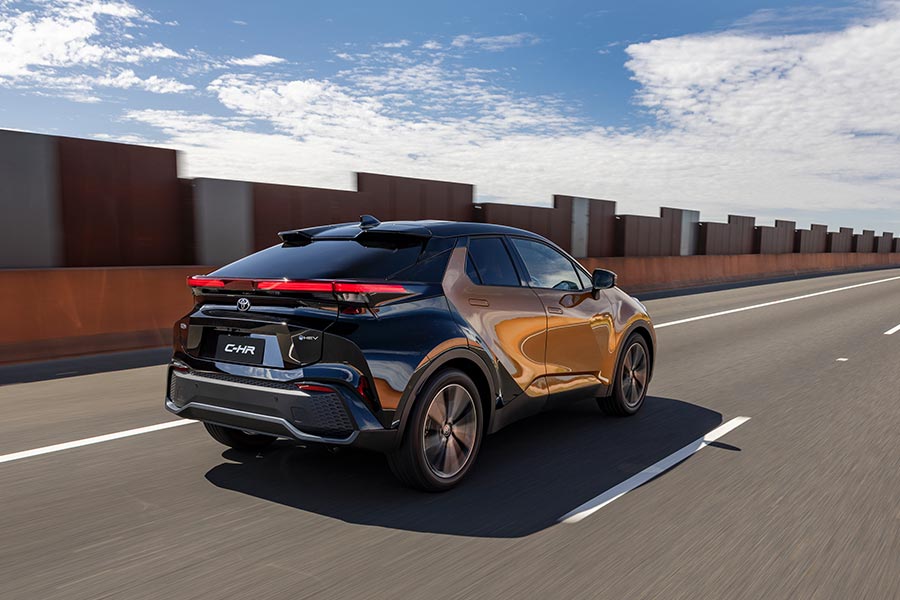
Make no mistake, the GR Sport is six litres short of being a supercar, however a brief stint through some winding country roads revealed a charming little machine with more than enough dynamic talent for a mainstream small SUV.
It’s agile and easy to wrangle, but you need to work its hybrid powertrain hard to get things moving.
On the other hand, the smaller 1.8-litre petrol-electric powertrain in the Koba feels better suited to city driving. It’s not sluggish per se but you wouldn’t necessarily call it zippy either.
Challenge it with some high-speed cornering and the C-HR Koba holds up surprisingly well, even without the surety of the GR Sport’s all-paw grip. Throw it into a corner and it’s just as confident, thanks in part to Bridgestone Turanza rubber that provides plenty of grip.
While it feels more than capable of tackling a spirited country road, the C-HR Koba runs out of puff quickly and you don’t have to worry about potential wheelspin when you pin the throttle from a standstill; its lack of power prevents any such chaos.
In terms of the ride, all C-HR models steer towards the firmer side of the comfort corridor, with taut suspension that creates a generally sporty feel, while still offering decent compliance over bumps.
The steering is light yet direct, but you can make it more meaningful by flicking to Sport mode to stiffen it up (while also improving throttle response) if you so choose.
No matter which C-HR you’re driving, the CVT automatic ensures the engine drones at constant revs, which only gets louder under load. In a cabin with no music or chatter, it’s all you’ll hear most of the time, even with decent sound insulation that otherwise does a great job of shielding passengers from road noise.
Based on a revised version of Toyota’s TNGA-C platform, the new C-HR is 4362mm long, making it 28mm shorter than before, but the wheelbase remains at 2640mm. It’s also 37mm wider than its predecessor.
As with the first generation, the C-HR’s small stature makes it easy to place on the road and a breeze to manoeuvre around town, even if rearward vision is compromised by the tiny rear window and think C-pillars.
Should I buy a Toyota C-HR?
There’s no doubt the 2024 Toyota C-HR is much improved over the car it replaces.
It’s smarter and safer, arguably looks cooler – or at the very least, more futuristic – and brings improved fuel efficiency thanks to Toyota’s latest battery-electric technology.
But all that comes at a huge cost, and there are plenty of alternatives that either offer more bang for your buck in terms of space and performance or simply cost less while being just as (if not more) enjoyable to drive.
2024 Toyota C-HR Koba at a glance:
Editor’s Rating: 7.3/10
| Price: $49,990 (plus on-road costs) |
Transmission: Continuously variable automatic |
| Available: Now |
Fuel: 4.0L/100km (ADR Combined) |
| Powertrain: 1.8-litre four-cylinder petrol-electric |
CO2: 89g/km (ADR Combined) |
| Output: 72kW/142Nm (electric motor: 70kW/185Nm) |
Safety Rating: Not tested |
| Combined output: 103kW |
Disclaimer: Images supplied by Toyota Australia.
This article was prepared by an independent author. The information contained in this article represents the views and opinions of the original author, and is based on research carried out by the original author. The appearance of the article on Maxxia's website does not constitute an endorsement of its content by Maxxia in any way. The article has been made available for informational purposes only and should not be taken as advice. While all reasonable care has been taken to ensure that the statements made by the original author in the article are fair and accurate, Maxxia does not guarantee or warrant the accuracy or completeness of this information and will not be liable for, or in connection with, any loss or damage suffered as a result of any inaccuracies, errors or omissions or your reliance on this information. You should independently research and verify information before making any decision in respect of a vehicle.
News
By Carsales Staff
Isuzu has updated its popular MU-X seven-seat SUV with a wider range of model variants thanks to the introduction of a new entry-level four-cylinder engine option.
Already offered on the related D-MAX ute range, the availability of a smaller capacity, more fuel efficient 1.9-litre turbo diesel expands the line-up with three additional models.
But, while the entry ticket has been made more affordable, the price of existing models has increased between $500 and $2000 without any additional features.
“Increasing the price of the 24MY MU-X range was a decision not taken lightly, with all options deeply considered,” said Isuzu Ute Australia managing director Junta Matsui, referencing increasing production and shipping costs as the driving factor.
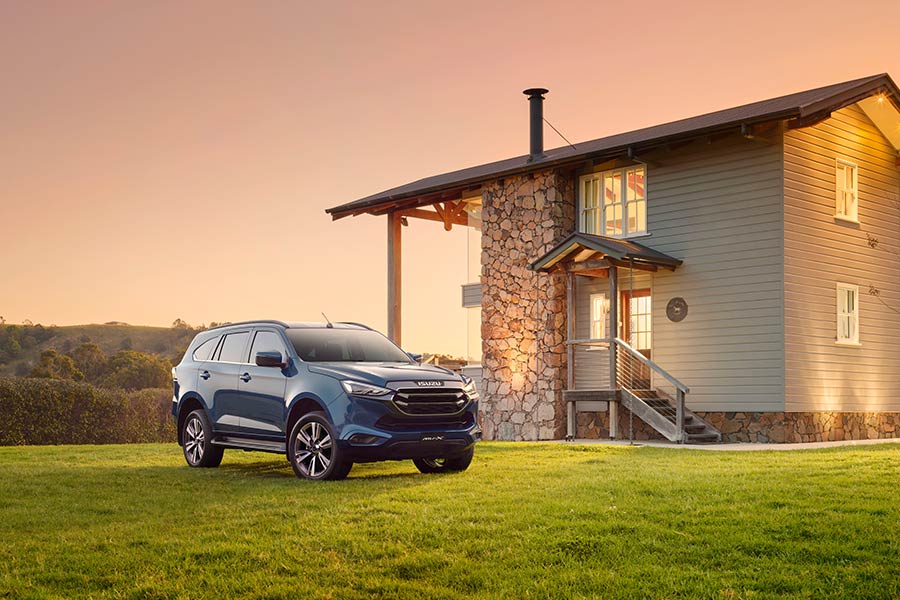
“We’re confident that value for money has been maintained across the 24MY MU-X range and the addition of the 1.9-litre turbo-diesel engine gives customers a more affordable option – not just at the showroom, but down the track, as it is up to 10 per cent more fuel-efficient than our 3.0-litre engine.”
The 1.9-litre four-cylinder turbo diesel is offered on two model grades, the entry-level LS-M (in 4x2 and 4x4) and mid-spec LS-U (exclusively in 4x4) with prices starting at $47,000 plus on-road costs. That equates to a $2000 discount over the equivalent version with the carry-over 3.0-litre four-cylinder turbo diesel.
The smaller engine generates 110kW of power and 350Nm of torque (compared to the unchanged outputs of 140kW and 450Nm for the 3.0-litre) and sees a reduction in braked towing capacity to 3000kg (from 3500kg) but an improvement in fuel economy.

In both rear-wheel drive and 4x4 configurations the 1.9-litre MU-X consumes an average of 7.4L/100km, whereas the 3.0-litre models have claimed averages of 7.8L/100km and 8.3L/100km respectively.
No changes have been made to the MU-X standard equipment list across the range.
Key features on the base LS-M grade include 17-inch alloy wheels, cloth upholstery, polyurethane steering wheel and gear selector, a 7.0-inch infotainment system, smartphone mirroring, digital radio, a four-speaker sound system, keyless entry, a reversing camera and LED headlights.
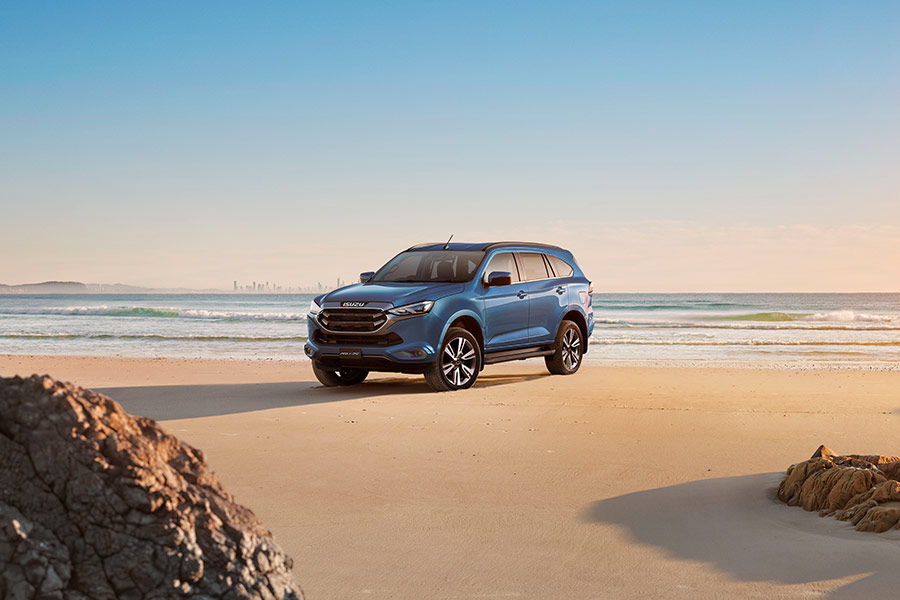
The LS-U adds 18-inch alloys, tyre pressure monitoring, dual-zone climate control, a 9.0-inch infotainment interface with embedded sat-nav, eight-speaker sound system, walk-away locking, LED fog lights, powered tailgate and front parking sensors.
Flagship LS-T variants up the ante with 20-inch alloys, leather upholstery, power-adjustable and heated front seats, remote engine start and LED ambient interior lighting.
All Australian-market MU-X SUVs feature an Aisin six-speed automatic transmission while the 4x4s come with Rough Terrain Mode, low-range gearing and a locking rear differential.

How much does the 2024 Isuzu MU-X cost?
- LS-M 1.9L 4x2 – $47,400
- LS-M 3.0L 4x2 – $49,400 (+$500)
- LS-U 3.0L 4x2 – $55,900 (+$500)
- LS-T 3.0L 4x2 – $63,400 (+$2000)
- LS-M 1.9L 4x4 – $53,400
- LS-U 1.9L 4x4 – $59,900
- LS-M 3.0L 4x4 – $55,400 (+$500)
- LS-U 3.0L 4x4 – $61,900 (+$500)
- LS-T 3.0L 4x4 – $67,990 drive-away (+$2000)
* Prices exclude on-road costs, except LS-T (drive-away)
Disclaimer: Images supplied by Isuzu Trucks Australia.
This article was prepared by an independent author. The information contained in this article represents the views and opinions of the original author, and is based on research carried out by the original author. The appearance of the article on Maxxia's website does not constitute an endorsement of its content by Maxxia in any way. The article has been made available for informational purposes only and should not be taken as advice. While all reasonable care has been taken to ensure that the statements made by the original author in the article are fair and accurate, Maxxia does not guarantee or warrant the accuracy or completeness of this information and will not be liable for, or in connection with, any loss or damage suffered as a result of any inaccuracies, errors or omissions or your reliance on this information. You should independently research and verify information before making any decision in respect of a vehicle.
Reviews
By Feann Torr, carsales.com.au
Nissan is driving in a different direction towards the horizon of low emission mobility. The Japanese brand has received critical acclaim for its unique solution for petrol-electric hybrids, called e-POWER, since it was first introduced on the latest generation X-TRAIL mid-sized SUV.
And now it has made the technology, which flips the relationship between petrol and electric motors, more accessible and more affordable by transferring it to the smaller QASHQAI SUV.
In most hybrid vehicles, the electric motor simply supports the petrol engine by providing additional power when required to reduce fuel consumption. With e-POWER, the petrol engine acts as an on-board generator to provide power to the battery pack, essentially making it an electric vehicle.
Now available in the QASHQAI, it is a compelling option for eco-conscious buyers willing to pay a premium. Let’s explain why.
How much does the Nissan QASHQAI e-POWER cost?
The 2024 Nissan QASHQAI e-POWER is exclusively available in the range-topping Ti trim and is priced from $51,590 plus on-road costs, which is quite expensive for a small SUV from a mainstream brand.

That equates to a $4200 premium for the powertrain alone over the equivalent petrol-only flagship version, as it comes equipped with the same, admittedly extensive, list of standard equipment that includes a massive panoramic glass sunroof, three digital screens, big 19-inch alloy wheels, leather trim and more.
Nissan is expected to release cheaper versions of the QASHQAI e-POWER ‘electric drive’ hybrid in due course, but for now rivals like the Hyundai Kona Hybrid and Toyota Corolla Cross Hybrid start much lower, from around $36,000, and have more model diversity.
Even the Honda HR-V hybrid is cheaper than the Nissan at $47,000 drive-away, while the plug-in hybrid Mitsubishi Eclipse Cross PHEV starts from $47,290 plus ORCs.
Aftersales coverage includes a fairly standard five-year warranty and an above-average five-year roadside assistance program.
Capped-price servicing across five years is pegged at $2007 if you pre-pay at the beginning or $2230 if you pay annually or every 10,000km, whichever comes first.
That works out to around $400 per year (pre-paid) on average, and like the warranty, pre-paid service plans are transferrable if you on-sell the vehicle.
Notably, the e-POWER model is considerably cheaper to service than the petrol-only QASHQAI, which costs around $100 more per 12-month/10,000km service.
What equipment comes with the Nissan QASHQAI e-POWER?
The QASHQAI is Nissan’s most popular model in Europe, and it comes as no surprise that this UK-sourced flagship is crammed with premium equipment given the competition it faces from more fashionable brands like Citroen, Peugeot, Skoda, and Volkswagen.
To that end, the list of standard equipment reads more like a genuine luxury vehicle than a mainstream city SUV, with items including a 10-speaker Bose stereo with subwoofer, quilted leather seat upholstery with heated and massaging front seats (and memory settings for the driver’s position), a heated steering wheel and a large panoramic glass roof that makes the cabin feel bigger and brighter.
Ambient LED cabin lighting is also part of the Ti package, as is a wireless phone charger, a trio of large digital screens including embedded satellite navigation on the central screen, dual-zone automatic climate control, a powered tailgate with gesture (foot kick) control and 19-inch alloy wheels.
What technology does the Nissan QASHQAI e-POWER feature?
Aside from the luxurious appearance of its fancy seats, the big drawcard as you step into the 2024 Nissan QASHQAI e-POWER Ti are the twin 12.3-inch digital screens.
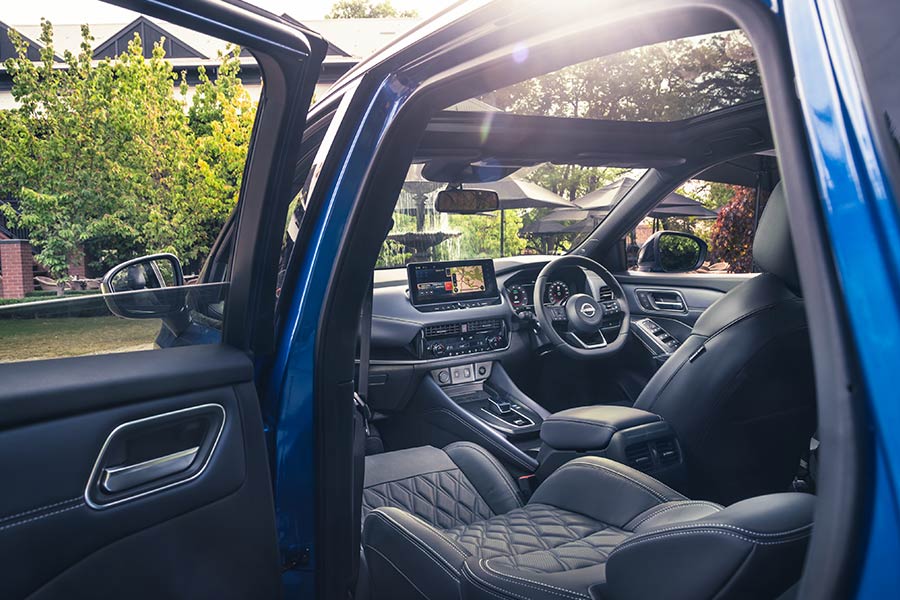
The central touchscreen has clear, sharp visuals and features wired and wireless Apple CarPlay but only wired Android Auto.
Embedded sat-nav is a nice touch, especially when you’re out of mobile phone range. And, while the menu system is intuitive, nicely arranged and delivers prompt touch response, the operating system lacks the depth of some rival small SUVs.
Despite digging around through the menu structure, I couldn’t find an energy flow menu to disseminate the interplay between battery, engine, generator, and inverter on the main screen. However, there is a graphic on the 12.3-inch digital instrument cluster that is somewhat basic but does the job.
The digital instrument display is generally very good, with plenty of driving data along with adjustable visual elements and themes.
The third and final screen, a 10.8-inch colour head-up display (beamed onto the windscreen directly in your line of sight), is very impressive with clear, vibrant visuals showing the current speed limit, vehicle speed, navigation directions and so on.
A large wireless phone charger is joined by twin USB ports – A and C – located in the centre console, but the NissanConnect remote services available overseas are missing here and there’s no timeline for its introduction, which is a shame.
What is the Nissan QASHQAI e-POWER like inside?
The QASHQAI’s cabin presents well with plenty of surprising and delightful touches you wouldn’t expect from a mainstream brand.
The quilted leather seats are beautiful to look at and both supportive and comfortable to sit in for front seat occupants and match the tactility of the rest of the cabin’s materials and overall build quality.
The large 12.3-inch touchscreen dominates the centre of the dash but doesn’t feel out of place against the similar-sized digital instrument cluster and super-useful 10.8-inch head-up display. It’s a nice match of tradition and technology.
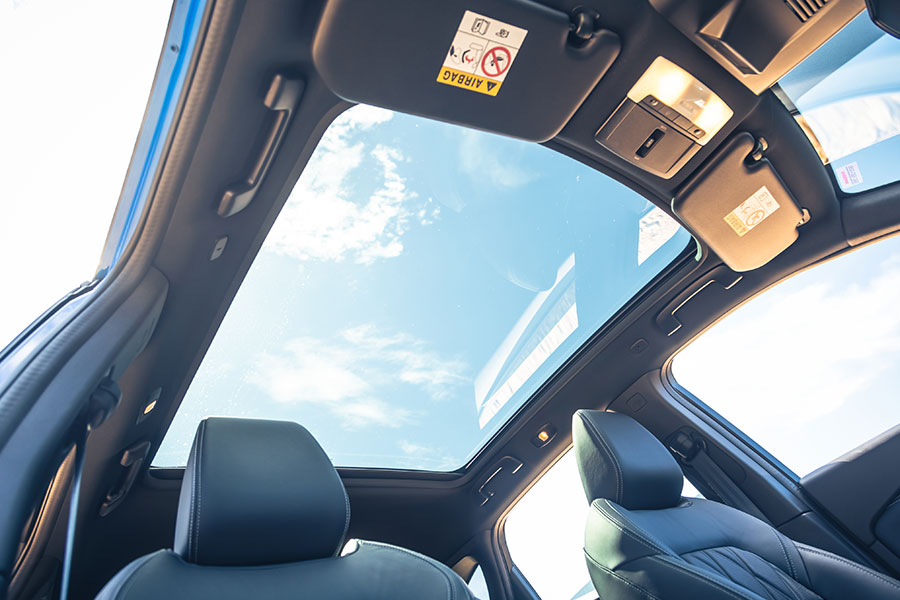
There’s also a very capable 10-speaker Bose stereo that blasts crisp and clear audio, a large wireless phone charger, two USB ports up front and a gorgeous panoramic glass roof that soaks the cabin with light to make it feel more spacious.
Rear-seat occupants are treated to a respectable amount of space for such a small SUV, as well as USB-A and USB-C ports, reading lights, air vents and a fold-out arm rest, while twin ISOFIX and triple top-tether child seat anchorages are there to secure little-uns.
And if you do have small children, the ultra-wide-opening doors (similar to the X-TRAIL) are a godsend; they make loading tiny people in and out of the vehicle a whole lot easier.
The power-operated tailgate can be opened hands-free by foot, laptop or metal bottle and reveals a versatile cargo area with hidden underfloor compartments and handy dividers that stop things rolling around.
Boot space is the same as the regular QASHQAI, which is impressive, although there’s no space-saver spare tyre now, replaced with a puncture repair kit.
How safe is the Nissan QASHQAI e-POWER?
Like all models in the range, the 2024 Nissan QASHQAI e-POWER Ti scores a maximum five-star ANCAP safety rating based on testing carried out in 2022.
On top of a strong safety cell and seven airbags, the e-POWER Ti comes with plenty of advanced driver assistance systems under Nissan’s ProPilot semi-autonomous driving suite, including adaptive cruise control, lane keep assist, blind spot detection/intervention and real-time traffic sign recognition that provides live speed-limit updates on the digital dashboard and head-up display.
Rear cross traffic alert, intelligent forward collision warning, driver attention alert and autonomous emergency braking (AEB) with junction assist and vehicle, cyclist and pedestrian detection are also part of the package, as are front and rear parking sensors.
There’s a 360-degree surround-view camera system and even auto parking if you want to let the QASHQAI slot itself into a car space instead.
A tyre pressure monitoring system and more exterior LED lights than a rave party are included, the latter comprising daytime running lights, automatic headlights with auto levelling and adaptive driving beams, fog lights and taillights.
What powers the Nissan QASHQAI e-POWER?
It’s under the skin where things get really interesting with the Nissan QASHQAI e-POWER.
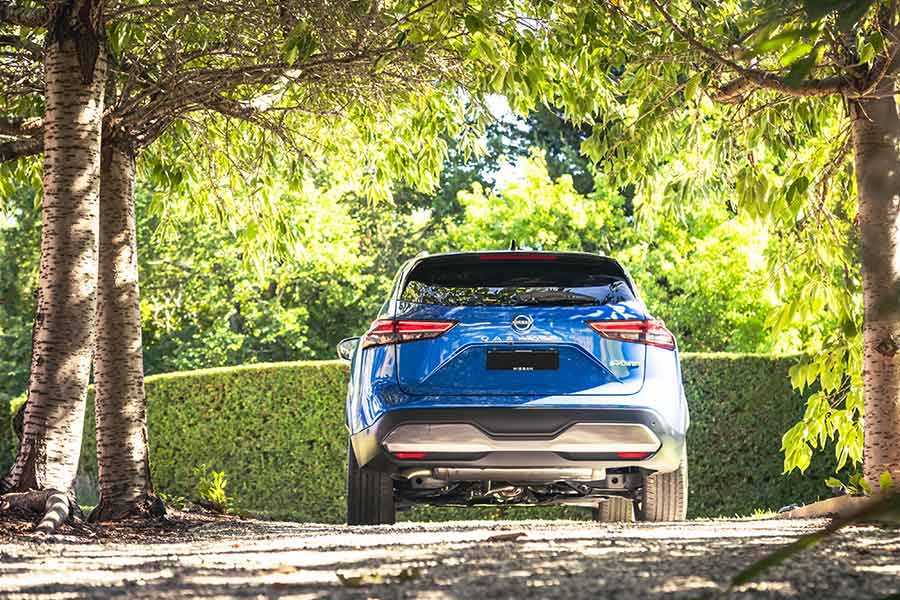
Where regular models have a 1.3-litre turbo-petrol four-cylinder engine that produces 110kW/250Nm and drives the front wheels through a continuously variable automatic transmission (which is all very conventional), the e-POWER has a slightly larger 1.5-litre three-cylinder turbo-petrol engine that isn’t connected to a transmission or the driving wheels at all.
Instead, it acts as a generator for an inverter that converts the power to electricity for the 2.1kWh lithium-ion battery pack, which then provides energy for the e-motor that drives the front wheels.
It might sound complicated, but the system is rather simple and creates a vehicle that has all the driving characteristics of a proper electric car with the driving range and quick refuelling properties of a conventional vehicle.
Officially, the petrol engine produces 116kW of power, but because the e-motor provides the motive power the QASHQAI e-POWER offers 140kW of power and 330Nm of torque, which makes it one of the most powerful vehicles in its class.
Even when the engine is purring away to charge the battery or feed the invertor (or both) it’s reasonably quiet thanks to the four-stroke engine’s variable compression set-up, which ranges between 8:1 to 14:1 depending on demand and in turn keeps revs relatively low while maximising torque.
Active sound cancelling works just like the popular headphones (using the Bose subwoofer to generate a counter-frequency in this case) and the cabin is surprisingly hushed.
Another benefit of this range-extending set-up is the removal of Nissan’s CVT (continuously variable transmission). Instead, a one-speed automatic reduction drive is used here, ensuring no mechanical interruption to acceleration, which is seamless.
The e-POWER system features regenerative braking technology that delivers wasted energy under deceleration back into the battery pack to further reduce fuel consumption and improve driving range. But it does not require owners to plug-in to recharge.
Instead, just fill-up the 55-litre fuel tank at a service station as you would a normal car, and the QASHQAI e-POWER offers a theoretical driving range of more than 1000km on a full tank.
How fuel efficient is the Nissan QASHQAI e-POWER?
Can you hear that? It’s a penny dropping. So, is the $4200 premium for the 2024 Nissan QASHQAI e-POWER Ti system worth it?
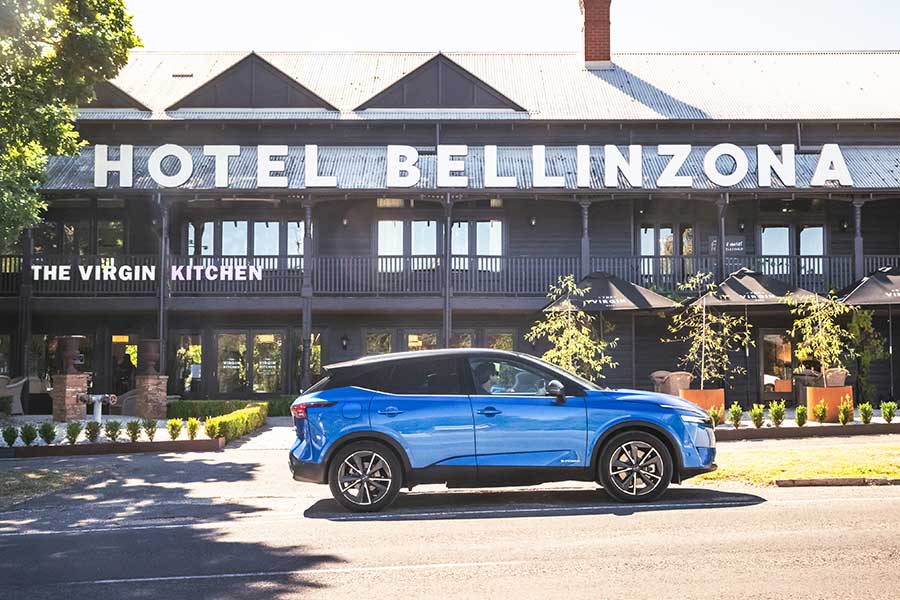
Nissan reckons it’s around 15 per cent more efficient than the petrol-only QASHQAI, consuming a claimed average of 5.2L/100km on the official combined-cycle test versus the conventional SUV’s 6.1L/100km.
Across the launch drive, we finished with a 5.5L/100km scorecard, which isn’t too shabby considering it is carrying an extra 200kg of mass… and especially when we averaged 8.1L/100km in the regular QASHQAI last year.
There’s a one-pedal driving system that is probably the most effective way to drive economically, with strong recuperative braking occurring when you lift off the throttle pedal.
What is the Nissan QASHQAI e-POWER like to drive?
During the launch we spent about 20 per cent of our vehicle evaluation time in urban areas while the rest was on 80km/h arterial roads, 100km/h freeways, and country roads.
And for the most part, the 2024 Nissan QASHQAI e-POWER Ti was extremely pleasant to drive.
It stands to reason the QASHQAI e-POWER does its best work at slower speeds and in stop-start scenarios, but by the end of the first stint, a 300km drive (with a high average speed of 71km/h), the figure settled at 5.5L/100km.
Driven sedately (which was our modus operandi for the most part), the QASHQAI e-POWER is quiet, smooth, and refined. Conversation flows easily in the hushed cabin, the massaging seats with three modes and different intensity settings adding a touch of luxury.
Push the throttle and the engine’s presence emerges with a hushed tone in the background. It’s unusual to listen to its static engine speed rather than hearing the revs rise in direct relationship to speed. But, once the novelty disappears, so does the engine’s faint intrusion. You’d hardly know it was there.
At full throttle, acceleration is swift (0-100km/h in 7.9 seconds is the claim), and despite the extra mass it carries around via all the hybrid gubbins, the QASHQAI e-POWER has a lot more spring in its step compared to the regular petrol models.
Its ability to soak up road imperfections is more than acceptable, riding across minor ruptures and gashes in the surface with relative comfort. That said, it doesn’t feel quite as nimble tracking through corners as the petrol-only QASHQAI.
According to Nissan’s European engineering corps, almost every element of chassis (dampers, springs, anti-roll bars, bushes) has been tuned to accommodate the extra 200kg of mass, but it doesn’t quite have the confidence of the regular car, with more body roll and less grip when you dial up the cornering tempo.
Can the Nissan QASHQAI e-POWER go off-road?
There aren’t many cars in the QASHQAI’s class that you could consider driving any further off the beaten path than a dirt road or gravel driveway.
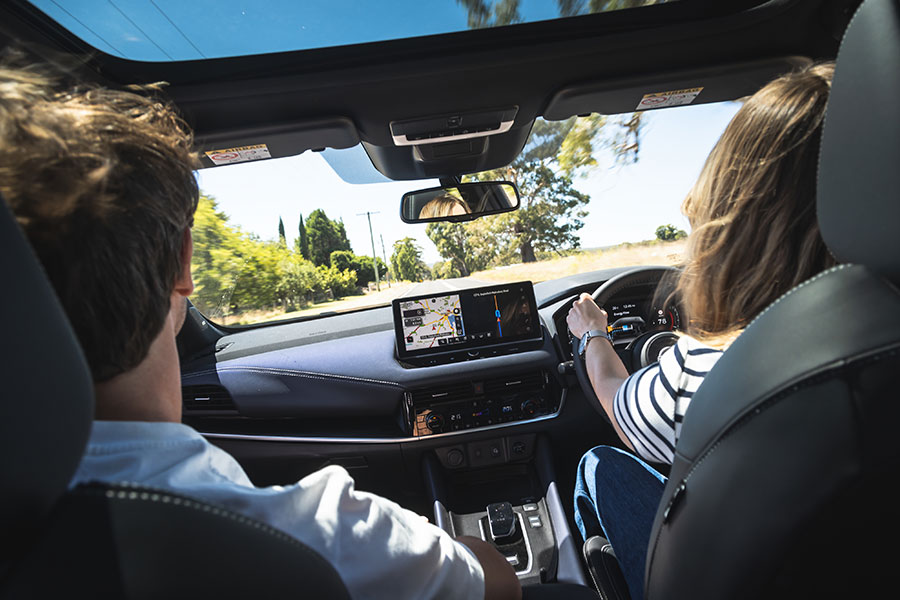
Like many of its rivals, the QASHQAI e-POWER is only front-wheel drive so there’s the first sign it’s not built for much more than the urban jungle. Plus, it rides on low-profile 19-inch tyres that aren’t much chop in the rough stuff and more prone to punctures than proper off-road rubber.
It does have three drive modes – Eco, Normal and Sport – that alter the throttle, regen and traction control to create faintly different driving characteristic. But there’s nothing specific for off-road. So, no… the QASHQAI e-POWER isn’t really suited to much more than light-duty dirt road driving.
Should I buy a Nissan QASHQAI e-POWER?
On first impression, there’s a lot to like about the 2024 Nissan QASHQAI e-POWER.
The concept of a range-extending petrol-powered hybrid that never needs to be plugged in and has no range anxiety-inducing quirks is appealing.
It is smooth and quiet to drive – just like an EV – has an upmarket ambience and we’re happy with the real-world fuel consumption figure of 5.5L/100km achieved on launch; we could certainly get it lower with more urban driving.
But is it $4200 better than the standard Nissan QASHQAI Ti, which has the same equipment?
It’s hard to say definitively one way or the other after driving it for a couple of days because the circa-15 per cent fuel saving would take a long time to recoup.
Then again, it offers a perfect stop-gap solution for those afraid to commit to a fully electric vehicle, offering all the good bits of an EV in terms of how it drives without compromising driving range and the convenience of quick re-fills.
2024 Nissan QASHQAI e-POWER Ti at a glance:
Editor’s Rating: 7.5/10
| Price: $51,590 (plus on-road costs) |
Transmission: Single-speed reduction gear |
| Available: Now |
Fuel: 5.2L/100km (ADR Combined) |
| Powertrain: 1.5-litre three-cylinder turbo petrol-electric |
CO2: 117g/km (ADR Combined) |
| Output: 116kW (electric motor: 140kW/330Nm) |
Safety Rating: Five-star (ANCAP 2022) |
| Combined output: 140kW/330Nm |
Disclaimer: Images supplied by Nissan Australia.
This article was prepared by an independent author. The information contained in this article represents the views and opinions of the original author, and is based on research carried out by the original author. The appearance of the article on Maxxia's website does not constitute an endorsement of its content by Maxxia in any way. The article has been made available for informational purposes only and should not be taken as advice. While all reasonable care has been taken to ensure that the statements made by the original author in the article are fair and accurate, Maxxia does not guarantee or warrant the accuracy or completeness of this information and will not be liable for, or in connection with, any loss or damage suffered as a result of any inaccuracies, errors or omissions or your reliance on this information. You should independently research and verify information before making any decision in respect of a vehicle.
Reviews
By Feann Torr, carsales.com.au
Subaru claims its sixth generation Impreza is an ‘all-new’ model, but you wouldn’t know it. The Impreza has been a mainstay for the Japanese brand for more than 30 years, but times have changed since it was first introduced, and SUVs have taken over as the default choice for small car buyers.
As such, even though the company claims the 2024 Subaru Impreza is a wholesale model change, it is more of a re-skin as it still shares the same fundamental basics – the platform, engine, and transmissions – as its predecessor.
There is some new-ness that commands attention, like the big digital display in the cabin and several other subtle improvements, but there’s also a sense of familiarity about the Impreza that indicates Subaru has other priorities.
Let us explain why.
How much does the Subaru Impreza cost?
The latest Subaru Impreza was first revealed at the Los Angeles Motor Show in 2022 and has only just arrived in Australian showrooms.
It is available in three model grades – 2.0L, 2.0R and 2.0S – all of which share the same mechanical configuration, are exclusively offered with an automatic transmission and only available in a hatchback body style.
The range starts at $31,490 plus on-road costs for the entry-level 2.0L, rises to $34,990 (plus ORCs) for the mid-spec 2.0R and tops out at $37,990 (plus ORCs) for the 2.0S we’re testing here. That is until the flagship, warmed-up Impreza RS arrives later.
The higher prices make it one of the more expensive Asian hatchbacks in the small-car segment against rivals such as the top-selling Toyota Corolla (from $29,610), Hyundai i30 (from $24,000), Mazda3 (from $30,470) and Kia Cerato (from $27,060). However, none of these offer Subaru’s trademark all-wheel drive – except the high-performance GR Corolla… but that costs an eye-watering $64K.
Warranty provisions are typical at five years and unlimited kilometres, but there’s only one year of complimentary roadside assistance (linked to a car club membership in your state, such as RACV or NRMA), which is below average.
Service costs aren’t as low as the Corolla’s (few are) and you’ll pay an average of $475 per annual service or $2372 over five years or 75,000km, with 12-month/15,000km intervals.
What equipment comes with the Subaru Impreza?
The entire 2024 Subaru Impreza range comes with an extensive list of standard equipment, with all grades now fitted as standard with a jumbo 11.6-inch portrait-style central touchscreen, wireless phone charger, smart key and push-button start, automatic (dusk-sensing) LED headlights, LED taillights, power-folding door mirrors and USB-A and USB-C ports.
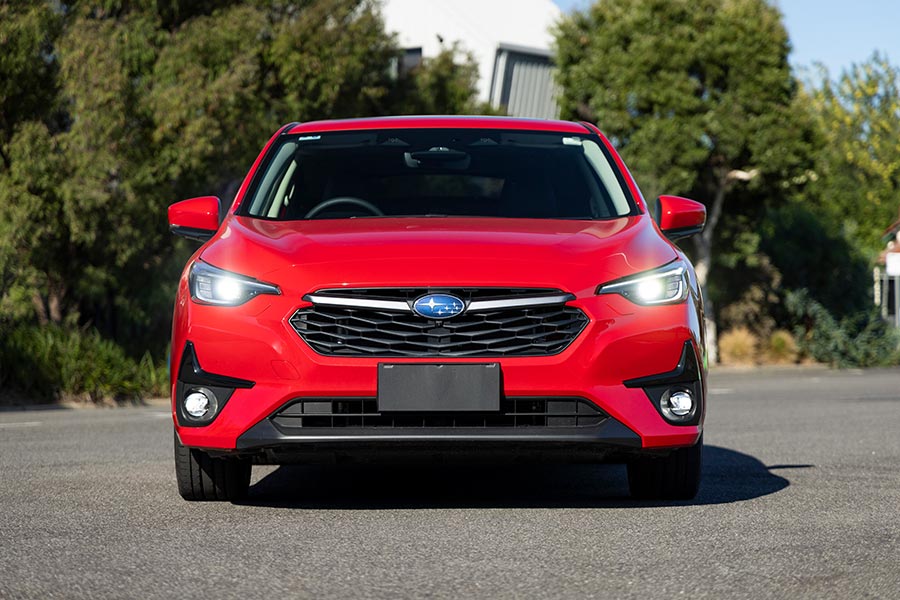
Dual-zone climate control, 17-inch alloy wheels, tinted rear windows, rain-sensing windscreen wipers, cloth-trimmed seats and both wireless Apple CarPlay and Android Auto are also standard across 2024 Impreza range, while this top-spec 2.0S adds embedded satellite-navigation, 18-inch alloy wheels and heated, leather-trimmed front seats – power-adjustable but only for the driver.
Also on the flagship model, it comes with an electric sunroof, 10-speaker Harman Kardon audio system, self-levelling headlights with high-beam assist, LED front fog lights, aluminium-faced sports pedals, and an auto-dimming rear-view mirror.
What technology does the Subaru Impreza feature?
Without doubt, the headline act inside the cabin of the 2024 Subaru Impreza is the portrait-style central touchscreen. It’s bigger than all its rivals’, it looks great – especially with Apple CarPlay or Android Auto – and the physical temperature controls mean you don’t have to drill into menus to quickly adjust the air-conditioning.
There’s no head-up display or a digital instrument cluster, which is disappointing given how similar the cabin design is to its predecessor’s. It’s almost like serving up eggs benedict without the rich buttery sauce.
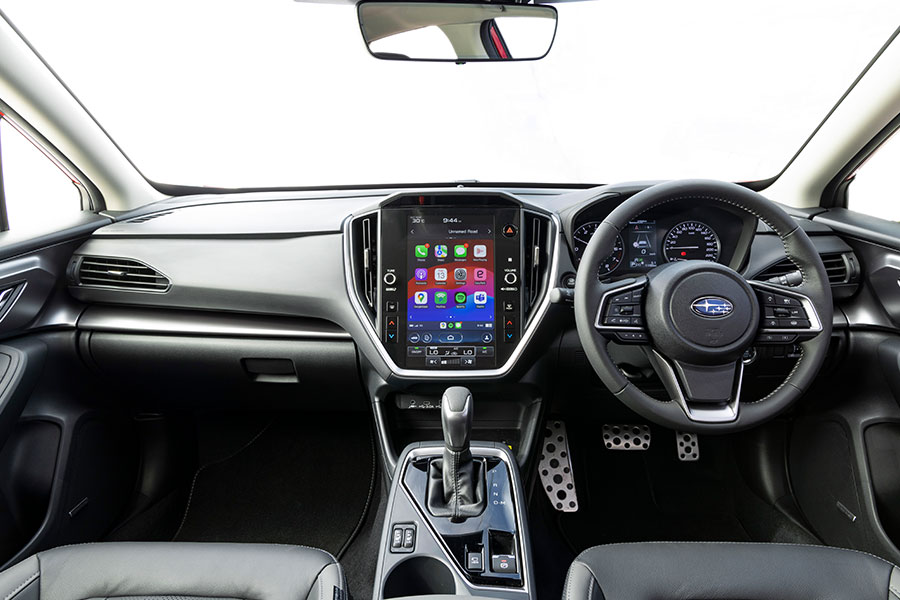
The analogue dials are simple and logical, and the compact 4.2-inch digital screen wedged between them offers plenty of info. Although the reversing camera is detailed and the overhead 360-degree view is helpful when parking in tight spaces, this doesn’t feel like a particularly advanced or innovative vehicle.
What is the Subaru Impreza like inside?
Beyond the tablet-style screen, there’s nothing new or exciting about the 2024 Subaru Impreza’s cabin.
While there are some cheap plastics scattered around, there’s also plenty of soft touch materials in the most tactile areas which elevates the sense of impeccable quality in its fit and finish.
The basic ergonomics are spot-on, from the comfortable and shapely front seats to the adjustability of its driving position and layout of the switchgear and controls. The driver gets eight-way power adjustment (with lumbar support), but the front passenger only has manual adjustments which smells of cost-cutting in this top-shelf variant.
That said, the 10-speaker Harmon Kardon audio system is good and, together with the electric sunroof, lends the cabin an upmarket ambience.
Apart from the large central bin and wireless device charging pad, storage solutions are average, but dual USB ports (both A and C connections) and an AUX port are handy. The tablet screen has voice recognition for certain functions, but it can be hit and miss.
If you’re upgrading from the previous fifth-generation Subaru Impreza you may feel a little short-changed when you notice several carryover interior parts, including the steering wheel.
The cabin’s overall look and feel is eerily similar to the ‘old’ Impreza and, together with a lack of air-vents for rear seat passengers and a 15 per cent smaller boot than before, it all feels a bit underwhelming.
How safe is the Subaru Impreza?
The 2024 Subaru Impreza has yet to be assessed by independent safety authority ANCAP, but it does come with an impressive safety suite, including nine airbags and Subaru’s latest ‘Eyesight’ sensory array.
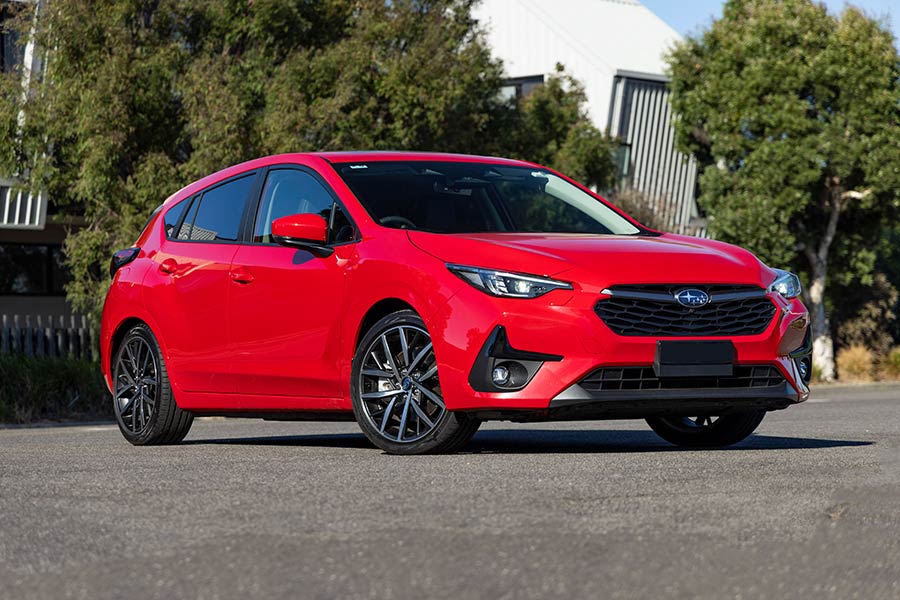
This includes an upgraded dual or ‘stereoscopic’ camera system mounted at the top of the windscreen that enables autonomous emergency braking (AEB), adaptive cruise control and automatic steering on the freeway via lane centring and lane departure prevention.
It also gets autonomous emergency steering and an intelligent speed-limiter via road sign recognition, plus there’s a blind spot monitor to alert drivers to cars they may not see behind and beside them, and rear cross traffic alert that’ll warn drivers of approaching cars when reversing out of tight or vision-limited car parks.
A facial recognition system is coupled with a distraction warning system that beeps if you take your eyes off the road for more than a few seconds, which can be annoying when trying to hold a conversation on dead-straight freeways, where the auto steering system does a good job of keeping the car on the straight and narrow.
What powers the Subaru Impreza?
Along with its ‘symmetrical AWD’ system (which is no longer a genuine full-time all-wheel drive system without a manual transmission), another signature powertrain feature of the 2024 Subaru Impreza is its flat four-cylinder engine.
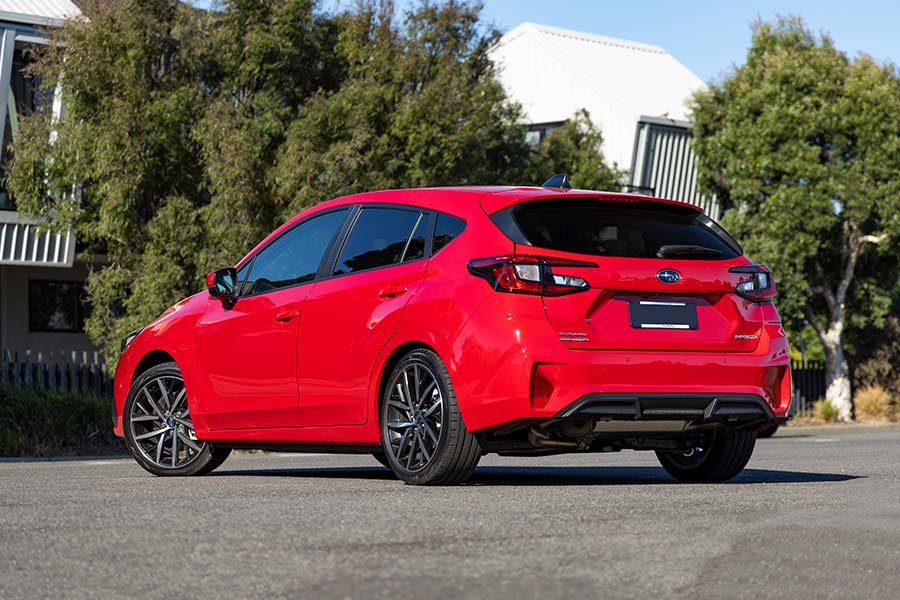
However, the novel engine type in the sixth generation Impreza is unchanged from the preceding model, which means power and torque outputs (115kW/196Nm) remain unchanged. That said, it’s still got competitive muscle compared to Japanese and Korean rivals.
Power is transferred to all four wheels via an automatic CVT (continuously variable transmission) that has eight ‘stepped’ gears if you tap on the steering wheel-mounted paddle shifters.
How fuel-efficient is the Subaru Impreza?
Because the Impreza has an AWD system it’s a bit heavier than most of its direct competitors and this negatively impacts fuel consumption. The 2024 Subaru Impreza 2.0S is happy to drink cheaper 91 octane petrol and has claimed fuel efficiency of 7.5L/100km, which is none too rosy these days.
Our testing saw record 9.0L/100km, which is not great and results in CO2 emissions higher than its 170g/km claim.
What is the Subaru Impreza like to drive?
The Impreza has always been at the top of its class for its all-round driving experience.
And it’s much the same with this new generation model, which even Subaru admits has been merely ‘finessed’ by its engineering division.
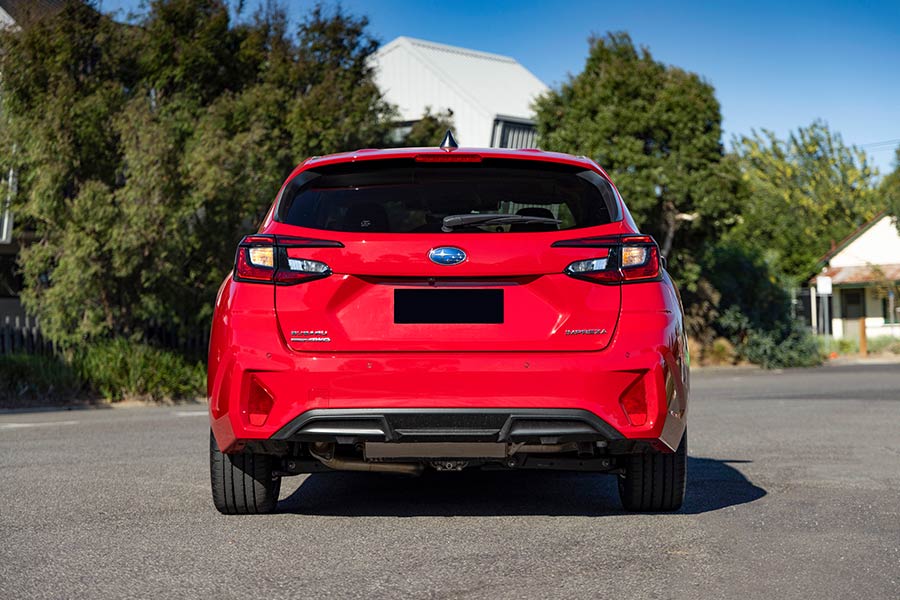
Thanks in part to its all-wheel drive system and the layout of its boxer engine (which Subaru touts as being symmetrical) that helps achieve a lower centre of gravity than more conventional configurations, the Impreza feels both nimble and surefooted that makes it enjoyable to drive in any condition.
With direct steering and compliant suspension, the chassis dynamics are respectable, and it doesn’t mind tucking into tighter corners. Indeed, unlike many newer rivals, it has more of an analogue, mechanical feel to the way it motivates, which adds a bit of character.
But some of that charm is dashed when you ask more of the engine, which is breathless and slow revving like the carryover powerplant it is. Granted, it works reasonably effectively with the CVT auto at low speeds, delivering satisfactory acceleration up to 60km/h, which makes it an adept suburban combatant.
But overtaking other cars on freeways and arterial roads at 80 or 100km/h reveals a level of lethargy in both the dated engine and transmission.
It’s a confident car when it rains and on dirt roads thanks to the AWD system, providing secure roadholding. Ride comfort is pretty good too, the suspension smoothing out potholes and poor-quality roads with relative ease.
Minor changes to the inner frame of the Subaru Global Platform architecture, which all the critical mechanical components are bolted to, are supposed to improve body rigidity while making the cabin a bit quieter, but without a back-to-back test with its predecessor it’s impossible to verify Subaru’s claims.
It certainly doesn’t feel quieter. The engine and CVT make a racket when revved and there’s noticeable wind noise around the windscreen and mirrors at higher speeds too.
Driving the Impreza is pleasingly effortless, if a little dull, and the soulless CVT and dated engine make it feel a generation behind more modern alternatives.
Can the Subaru Impreza go off-road?
Yes, it can! The AWD system is quite capable on dirt roads and can tackle challenging climbs that its rivals cannot. But it’s not a four-wheel drive in the same vein as a rugged ute or LandCruiser, as its ability is limited by its low ride height, with just 130mm of ground clearance meaning it’ll get snagged on rocks and washed-out ruts quick smart.

After all, this is a passenger car – not an SUV – albeit one with an above-average ability to traverse muddy roads or wet, grassy paddocks.
Should I buy a Subaru Impreza?
Subaru has very loyal owners, and many will automatically upgrade to the newer Impreza and appreciate the subtle improvements and, especially, the big digital display.
But, really, the 2024 Subaru Impreza feels more like a facelift than it does an all-new car as the promotional material insists. Granted, the cabin is a bit nicer, and safety tech is impressive.
But the aging powertrain, small boot and lack of rear-seat amenity don’t do it any favours. There’s little excitement or innovation here and, without a sedan option and no chance of a new WRX STI hero, there’s a sense that Subaru has either lost its mojo, is prioritising other models, or both.
There is nothing about the Impreza that would be deal-breaker for many new-car buyers, but the iconic nameplate deserves more than just a luke-warm update, and there are better small cars in terms of performance, value, economy, style, and substance.
Die-hard Subaru advocates might not be disappointed, but everyone else may find the 2024 Subaru Impreza stuck in the past.
2024 Subaru Impreza 2.0S at a glance:
Editor’s Rating: 6.9/10
| Price: $37,990 (plus on-road costs) |
Transmission: Continuously variable automatic with eight stepped ‘ratios’ |
| Available: Now |
Fuel: 7.5L/100km (ADR Combined) |
| Engine: 2.0-litre four-cylinder petrol |
CO2: 170g/km (ADR Combined) |
| Output: 115kW/196Nm |
Safety Rating: Not tested |
Disclaimer: Images supplied by carsales.
This article was prepared by an independent author. The information contained in this article represents the views and opinions of the original author, and is based on research carried out by the original author. The appearance of the article on Maxxia's website does not constitute an endorsement of its content by Maxxia in any way. The article has been made available for informational purposes only and should not be taken as advice. While all reasonable care has been taken to ensure that the statements made by the original author in the article are fair and accurate, Maxxia does not guarantee or warrant the accuracy or completeness of this information and will not be liable for, or in connection with, any loss or damage suffered as a result of any inaccuracies, errors or omissions or your reliance on this information. You should independently research and verify information before making any decision in respect of a vehicle.
News
By Carsales Staff
You win some and you lose some. That’s the case for the next-generation MG3, which is set to gain a petrol-electric hybrid powertrain but will relinquish its role as Australia’s most affordable new car when it arrives in local showrooms in the middle of 2024.
Unveiled for the first time at the Geneva Motor Show, the third generation MG3 promises to set new standards for performance, efficiency and refinement but is expected to cost around $5000 more than the outgoing version which currently sells for less than $20,000 driveaway.
That will leave the recently facelifted 2024 Kia Picanto (from $17,890 plus on-road costs) as the only new car remaining on sale in Australia from under $20,000.
The MG3 is expected to be available with two powertrain options, either with a conventional petrol motor or a petrol-electric hybrid with the latter likely to command a significant premium of up to $5000.
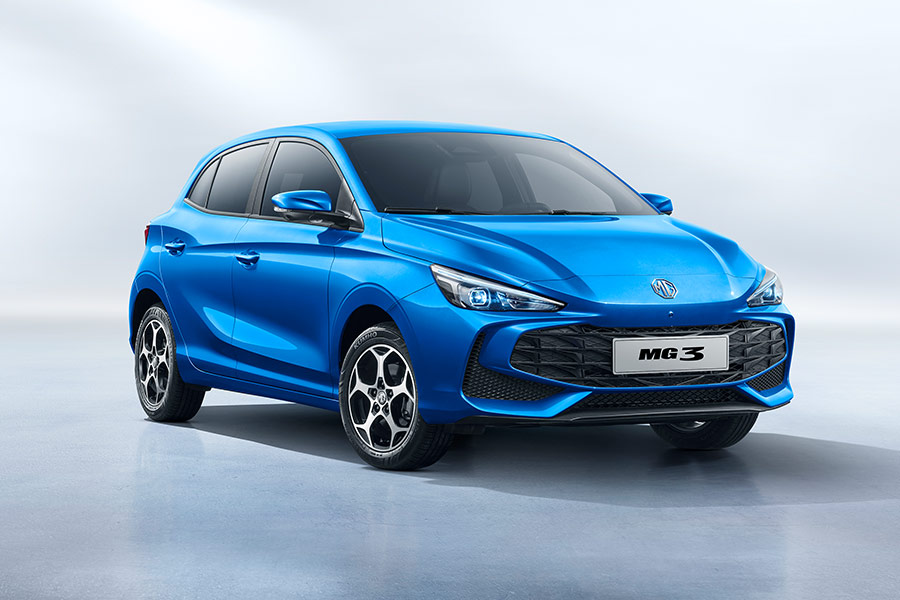
Final specifications and prices have yet to be confirmed for Australia, but eagle-eyed car spotters have already captured camouflaged pre-production models undergoing testing and evaluation on local roads.
But MG Motor Australia confirmed in a statement “…that, due to advancements in technology, safety, and specification, the new MG3 revealed at the Geneva Motor Show will mean the popular model will no longer be a sub-$20,000 car when it launches in Australia this year.
“There will be a price increase of around $5000 associated with the new model, thanks to the introduction of new world-class technology, safety updates and all-new specification.”
According to specifications revealed for European versions, where the MG3 will exclusively be offered with the hybrid set-up, the powertrain will link a lean-burning 1.5-litre petrol engine that generates 75kW/128Nm with a 100kW electric motor powered by small 1.83kWh lithium-ion battery.
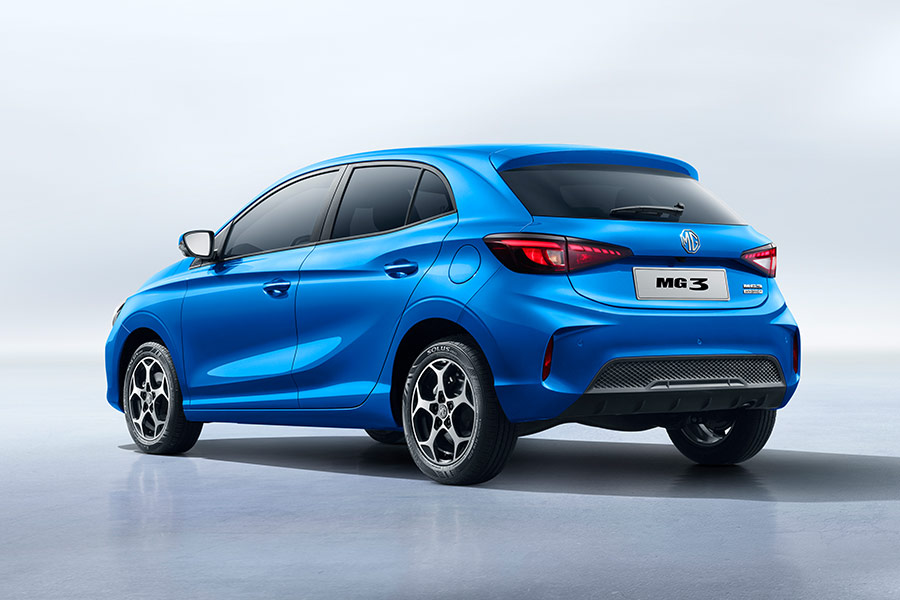
Together, they produce a combined maximum output of 143kW while consuming an average of 4.4L/100km.
The powertrain drives the front wheels through a three-speed – yes, three speed – automatic transmission, with MG claiming the electric motor is responsible for most of the ‘high load’ driving, such as initially moving away from a standstill and heavy bursts of acceleration with the petrol engine merely supporting it before taking over at higher and constant speeds.
By comparison, the Toyota Yaris Hybrid is more efficient (with an average fuel consumption figure of 3.3L/100km) but generates significantly less power (at 85kW).
Along with the extra performance, the new MG3 is physically larger than the car it replaces in almost every dimension and now measures 4113mm (+58mm) long, 1797mm (+68mm) wide and 1502mm (-7mm) high, while riding on a 50mm-longer (2570mm) wheelbase.
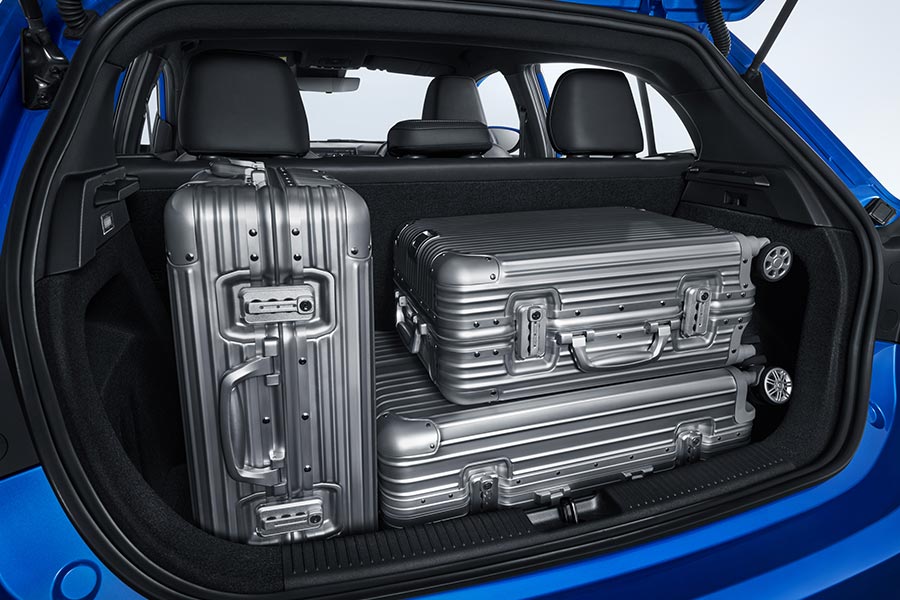
With more space inside for occupants and cargo, MG says the new city-hatch now has the largest boot in its class (293 litres).
In Europe, the new MG3 will be offered in three well-equipped grades – Standard, Comfort and Luxury – but even the most basic versions will offer a twin-screen dashboard with a 7.0-inch digital instrument cluster combined with a 10.25-inch infotainment touchscreen.
Both are said to benefit from enhanced graphics and improved responses. A row of piano-key shortcuts below the touchscreen have been retained to reduce driver distraction on the move.
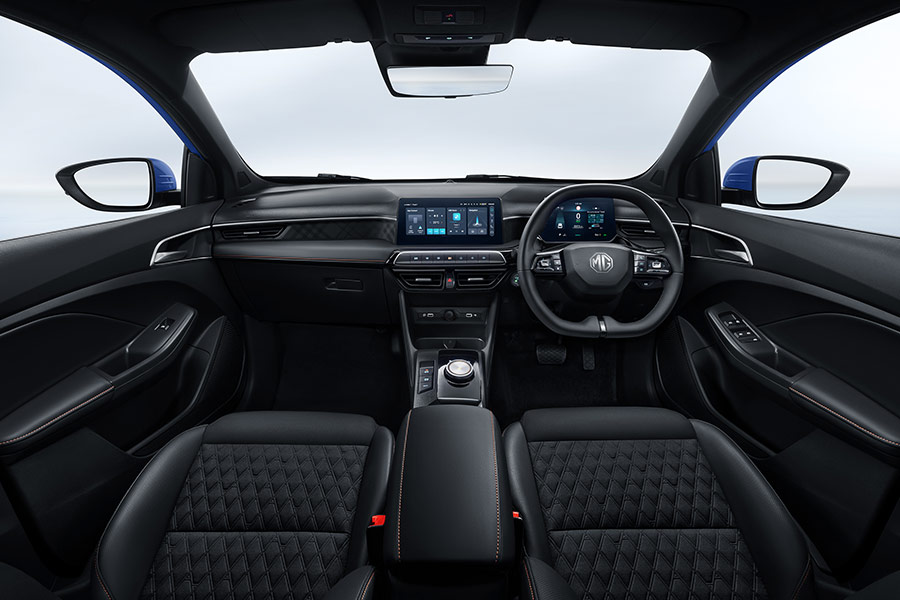
Sat-nav is now also standard, as is Apple CarPlay and Android Auto as well as the car-maker’s MG iSMART connectivity system.
There are also four USB ports, rear parking sensors and a reversing camera. Higher grades add leather seat trim, keyless entry, heated front seats and steering wheel, plus a 360-degree parking display.
Coming from the lowest base (with ANCAP controversially not rating the ageing existing MG3), the new model offers significant improvements in safety technology with the addition of autonomous emergency braking (AEB), lane keeping assistance, lane departure warning and adaptive cruise control with traffic jam assist.
More sound deadening are new engine and suspension mounts are said to reduce noise, vibration, and general harshness levels, while a stiffer chassis and lighter suspension components are claimed to improve grip and agility.
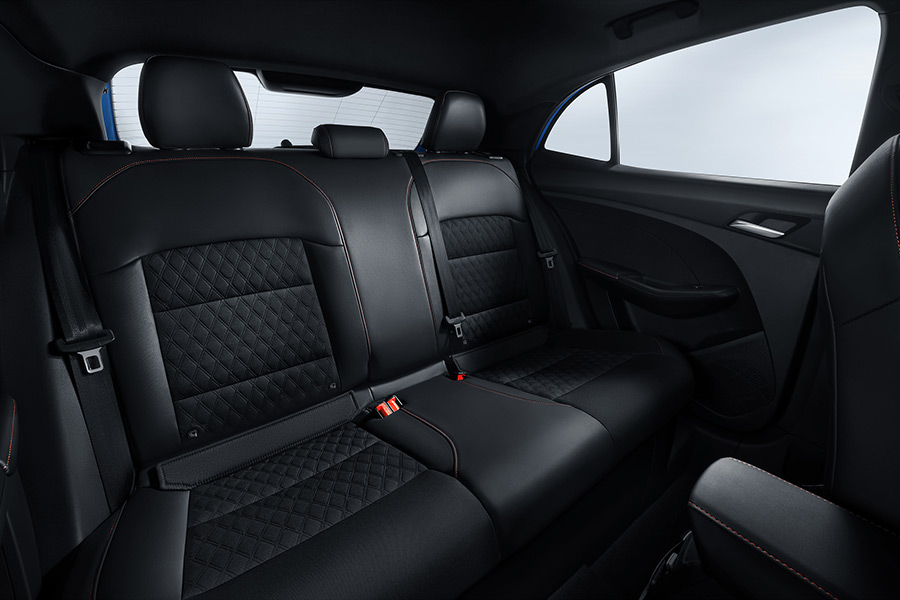
Europe’s new MG3 will be available with a choice of new alloy wheel designs and a fresh colour palette including York White, St Moritz Blue, Flaming Red, Morning Yellow, Pearl Black, Blade Silver, and Hampstead Grey.
The first MG3 launched in China in 2008 was never sold in Australia, and its 2011 successor only arrived here in 2016, when it became one of the cheapest new cars available and quickly outsold the Toyota Yaris, Mazda2, Suzuki Swift and Volkswagen Polo.
The third generation MG3 is expected to go on-sale in Australia by the middle of 2024.
Disclaimer: Images supplied by MG Australia.
This article was prepared by an independent author. The information contained in this article represents the views and opinions of the original author, and is based on research carried out by the original author. The appearance of the article on Maxxia's website does not constitute an endorsement of its content by Maxxia in any way. The article has been made available for informational purposes only and should not be taken as advice. While all reasonable care has been taken to ensure that the statements made by the original author in the article are fair and accurate, Maxxia does not guarantee or warrant the accuracy or completeness of this information and will not be liable for, or in connection with, any loss or damage suffered as a result of any inaccuracies, errors or omissions or your reliance on this information. You should independently research and verify information before making any decision in respect of a vehicle.
Reviews
By Sam Charlwood, carsales.com.au
Australians have always admired an underdog, but they love a winner. That much is true whether it is choosing a footy team or the car they drive. And, in the battle of the ‘burbs, the Mitsubishi Triton has long been revered as an unsung hero among the dual-cab ute.
It’s never been the champion against powerhouse rivals like the Toyota HiLux and Ford Ranger, as it hasn’t had the firepower to match them on performance, power, or payload. But the Triton has always punched well above its weight, by undercutting its competitors on value.
Now though, Mitsubishi reckons it has a genuine contender with its all-new sixth-generation Triton which offers more of everything but loses its competitive price position.
Is it truly the new benchmark? Our first impressions yielded some mixed results. Let’s find out why.
How much does the Mitsubishi Triton cost?
The 2024 Mitsubishi Triton arrives with a six-model line-up that starts at $43,690 (plus on-roads) for the entry-level GLX Double Cab Pick-Up with rear-wheel drive, which is $3200 more expensive than the equivalent model it replaces.
The range then moves through five versions with four-wheel drive, which starts with the only Club Cab model, the GLX+ at $50,340 (plus ORCs), then four variants of the Double Cab; GLX, GLX+, GLS and the flagship GSR we’re testing here which costs from $63,840 (plus ORCs). That’s a $7000 increase over its predecessor.
Work-ready single-cab and cab-chassis versions of the Triton are expected later in 2024. Mitsubishi has confirmed that models lower in the hierarchy will also be offered with a manual transmission, whereas the opening launch range is automatic-only.
While prices have increased significantly across the range, the Triton continues to undercut comparable versions of the Ford Ranger (starting from $43,280 plus ORCs) and Toyota HiLux (from $44,635 plus ORCs), though it moves further away from more affordable alternatives such as the GWM Ute (from $35,990 drive-away).
It means the Triton doesn’t quite hold the same compelling value equation it once did in Australia.
What equipment comes with the Mitsubishi Triton?
Even the most basic versions of the 2024 Mitsubishi Triton receive a modest increase in equipment levels along with wholesale changes in design, space and power.

In overall terms, the new Triton dual-cab is 15mm longer than before (5320mm), 50mm wider (1865mm) and rides on a 130mm-longer (3130mm) wheelbase, liberating a 35mm-longer tray (1555mm) and 49mm more shoulder-room (1479mm).
The Triton runs a ladder-frame chassis as before and has updated high-mount double-wishbone front suspension with increased travel, with a revised leaf spring layout at the rear – both complemented by larger-diameter shock absorbers.
The entry GLX is fitted with 17-inch alloy wheels and has cloth seat trim, keyless entry (though not keyless start), tyre pressure monitoring and air-conditioning.
The GSR flagship tested here brings 18-inch wheels, LED headlights, taillights, indicators and fog lights, dual-zone climate control, heated front seats, rear styling bar, roof rails, leather seat trim with contrasting orange stitching, soft interior padding, dash-mounted cup holders and power adjustment for the driver’s seat (but not the front passenger).
A quick flick through the specifications list reveals many creature comforts are exclusive to models higher in the range, while accessories including a tow bar are optional across the line-up. Other manufacturers are beginning to offer a tow bar standard on some models.
There’s a more positive story around aftersales, however.
Mitsubishi Australia ordinarily covers all its vehicles with a standard a five-year/100,000km warranty in Australia. However, if buyers follow the prescribed servicing scheduled through the car-maker’s national dealer network, the factory provision stretches to a 10-year/200,000km warranty with a 10-year capped-price servicing program (priced at $6690 over 10 years/150,000km, based on 12-month/15,000km intervals).
The manufacturer is also offering a full suite of accessories in-house with the new Triton, with items including a steel bull bar and underside protection, bonnet protector, snorkel, canopy, rear protection bar, sports bar, side protection bar and bed liner.
What technology does the Mitsubishi Triton feature?
The entire 2024 Mitsubishi Triton range gains a new 9.0-inch centre touchscreen display that controls all the key infotainment functions, including Apple CarPlay and Android Auto (both wired and wireless).
Higher-spec versions also offer digital radio, sat-nav and a wireless phone charging pad.
A bank of physical buttons and switchgear offers straight-forward access to simple functions, or shortcuts on the screen – to save you digging through needless sub-menus.

Elsewhere, the instrument cluster now gets a 7.0-inch digital readout that sits between two analogue gauges.
The display is clean and legible, though a far cry from full-length digital instrument clusters offered in rivals – most notably, the latest Ford Ranger.
What is the Mitsubishi Triton like inside?
From any seat inside the cabin of the new 2024 Mitsubishi Triton, occupants will notice a range of notable improvements, especially in the case of our GSR flagship.
Above all else, the longer wheelbase has extracted more space for rear seat passengers than before, allowing the Triton to stand up as one of the more spacious offerings in the class.
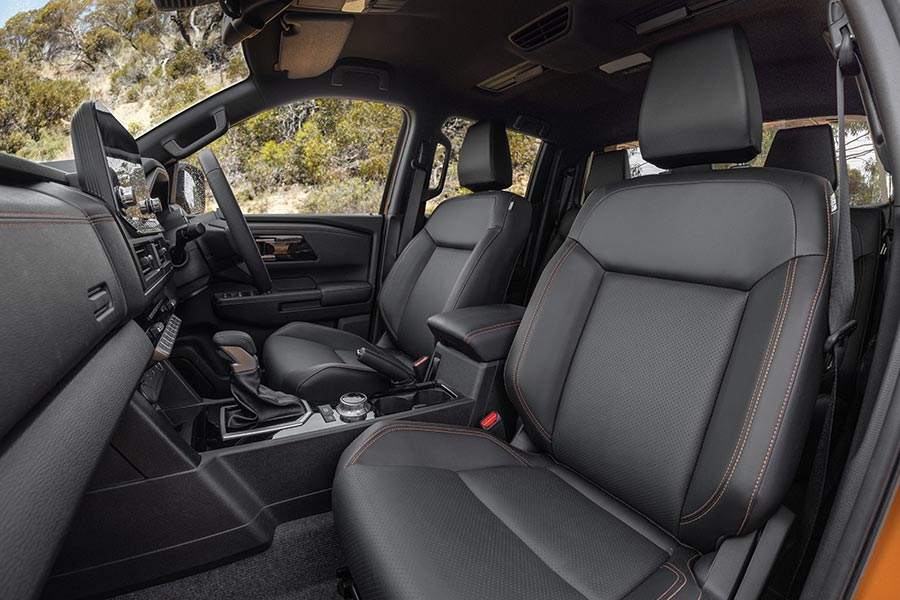
There is an obvious emphasis on the use of nicer materials and presentation, the updated dashboard design is more contemporary, and the cabin is littered with nifty storage solutions and amenity.
However, the Triton doesn’t quite match the sophistication of a higher-spec Ford Ranger, with harder surface treatments and obvious cost short-cutting, including a solid plastic circle on the steering column of our GSR test vehicle where a key barrel would usually reside on cheaper models.
Occupants are provided with the choice of USB-A and USB-C outlets in both rows of seating, while rear occupants also have access to roof-mounted air vents, though no vents at the traditional rear of the centre console.
The rear seat space is accommodating and suitable for a couple of adults on moderate journeys, accessed by dual grab rails on either side plus side steps on higher-specification models.
While the Triton offers ISOFIX child seat attachment points for the outboard rear seating positions, it makes do with a solitary top tether strap point behind the middle seat (instead of three solid individual top tether points across the bench).
It means occupants need to make use of a fiddly fabric looping strap to secure child seats, and they’re never quite as snug or secure as devoted top tether points behind each seat.
How safe is the Mitsubishi Triton?
The 2024 Mitsubishi Triton ushers in a host of new safety equipment that’s likely to lead to a five-star ANCAP safety rating in the future. It has yet to be tested by the independent crash testing authority.

This includes eight airbags, front and rear autonomous emergency braking (AEB) – the former with pedestrian and cyclist detection and junction assist – plus adaptive cruise control, lane change assist/blind spot warning, front and rear cross traffic alert, traffic sign monitoring and intelligent speed alert are all standard.
But - and this is a big but - there is a massive caveat around the intervention of some of these systems. This is most notably the case for the driver attention system and speed alert systems.
The former erroneously barks at the driver if they take a cursory glance away from the road, yawn, blink and much more. We can see the appeal – and understand the system’s value in ensuring a fleet-friendly five-star rating – but the interaction is annoying. And what’s more, you have to turn it off every time you start the car.
What powers the Mitsubishi Triton?
The 2024 Mitsubishi Triton is powered by what Mitsubishi claims is an “all-new” turbo-diesel engine. But the truth is it shares much in common with its predecessor.

The identical-capacity 2.4-litre diesel now employs two turbos – a small turbo for fast response at low revs and a larger turbo for top-end performance – to raise output to 150kW and 470Nm, a circa-10 per cent increase on both counts.
New pistons are said to be responsible for the power bump, while hydraulic valve lash adjusters are said to reduce maintenance. Happily, the Triton retains a timing chain, which is also good news for servicing costs.
The Triton’s six-speed automatic is virtually unchanged, though Mitsubishi has tweaked gear ratios to suit the uprated power and torque outputs.
The revised engine features a 17-litre AdBlue reservoir to ensure the Triton complies with the latest Euro 6B emissions regulations and can comfortably transition to more stringent targets on the immediate horizon.
Mitsubishi says development of the new Triton began in 2017, well before the release of new models including the Ford Ranger, the Ford-led Volkswagen Amarok and forthcoming all-new Toyota HiLux.
How fuel efficient is the Mitsubishi Triton?
Mitsubishi Australia claims the Triton has a combined fuel consumption average of 7.7L/100km, although we achieved around 9.5L/100km in a mix of conditions on launch, which included open-road and off-road driving.
What is the Mitsubishi Triton like to drive?
The 2024 Mitsubishi Triton takes a modest step forward with its on-road manners and refinement.
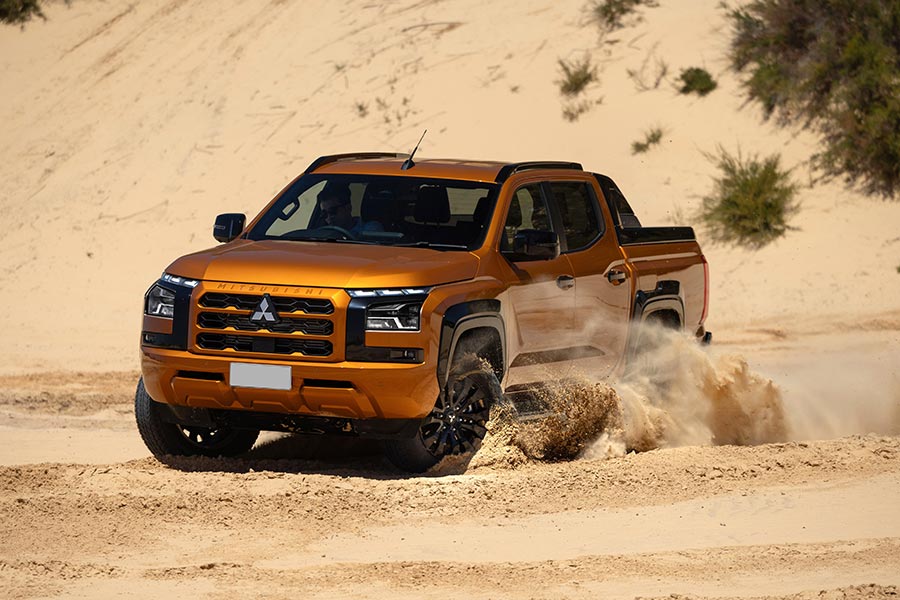
The new electrically assisted steering immediately imparts more lightness and refinement to the driver’s hands, helping offset the Triton’s larger turning circle while also eliminating its predecessor’s unnecessary levels of feedback.
The diesel engine offers a familiarly rugged character, shaking to life before settling into a muted thrum in regular conveyance. The start-up ‘shake’ is particularly noticeable in crawling traffic, where its new idle stop-start system takes effect.
The Triton feels marginally more settled than before in terms of its ride, and the larger footprint has yielded moderately more stability through corners and changes in direction.
Then again, there are some newer features that take away from the Triton’s charm. Namely, its safety systems.
The combination of driver attention monitoring and speed sign recognition becomes infuriating at times, with a cacophony of chimes and bells constantly sounding should you decide to momentarily veer your eyes away from straight-ahead, change speed zones or climb even 1km/h above the speed limit.
We’re all for safety, but these systems are a hindrance rather than a help, and a potential deal-breaker for prospective buyers.
Elsewhere, there are elements of the Triton driving experience which are largely the same as before.
For all its new parts and marketing hyperbole, the engine operates largely the same as before: it spins up nicely from around 1500rpm and delivers ample power and torque for around-town passage.
The six-speed automatic gearbox naturally pushes for economy and will kick down gears under harder acceleration to keep the engine at its sweet spot. However, the transmission lacks the intuitiveness and ratio count of more superior units on the market, while the engine can become quite vocal and strained as you push past the middling revs.
Moreover, Mitsubishi’s decision to delete the Triton’s steering wheel-mounted paddle shifters could potentially complicate downshifting under braking, especially when towing.
The fact the Triton still runs rear drum brakes and doesn’t take any giant leaps forward in engine performance should be considered if regularly towing heavy loads. That’s despite the 400kg increase in braked towing capacity (to 3500kg).
Similarly, while there are marginal improvements with the Triton’s ride, it is still afflicted by tremoring that is commonplace on most dual-cab utes, a virtue of load-rated leaf springs.
In earnest, the Triton still feels like one of the fussiest rides going, busy and fidgety over low-speed bumps and more susceptible to larger washouts in the road at high speeds. These traits are compounded by relatively noisy levels of road and cabin noise.
It means the Triton is mostly civilised and easy to live with but doesn’t really move the needle from a driving standpoint.
How good is the Mitsubishi Triton off-road?
If you intend to travel off the beaten track, then the new 2024 Mitsubishi Triton is a surprisingly capable jigger off-road, especially in flagship trim when the Super Select II 4x4 system and rear-locking diff is fitted standard.
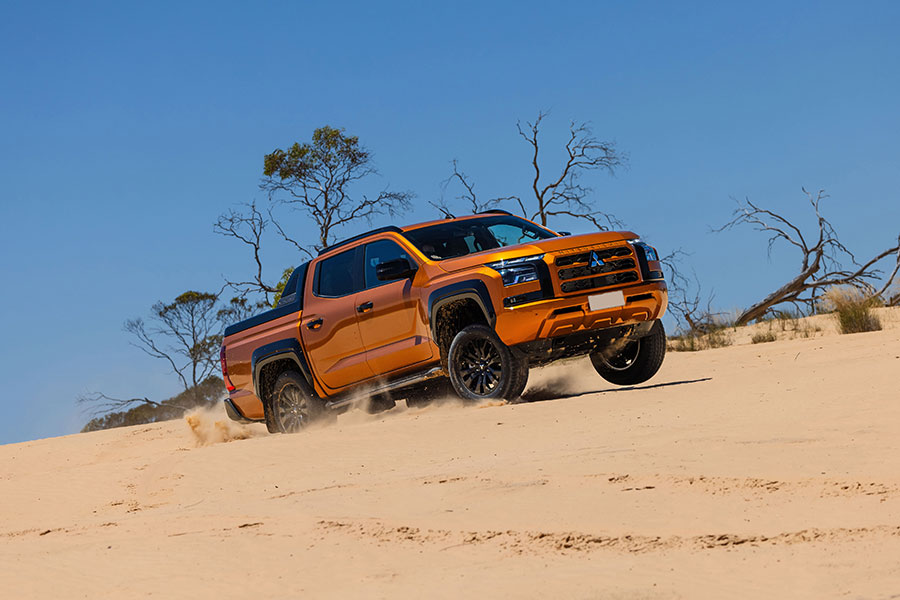
During the national launch, we drove across a 45-minute off-road loop with some modest climbs and descents with plenty of opportunities to assess its wheel articulation as well as a short stint on sand.
In truth, there was nothing on the circuit to really ‘frighten the Triton’ or indeed test just how far it would go.
We didn’t go too far in exploring its seven different off-road modes, but occasionally took issue with the intervention of the stability control, which would sometimes completely stop forward progress, and the dullness of its accelerator pedal.
That said, the lightness of the new electrically assisted steering is a boon when navigating tight obstacles and turns.
How much can the Mitsubishi Triton carry?
Significantly, the 2024 Mitsubishi Triton now brings an upgrade that matches its rivals for towing capacity, a 400kg increase over its predecessor to a maximum 3.5 tonne with a braked trailer.

A maximum downball weight of 350kg applies to all Triton variants.
Where the Triton does carry some cache is around payload when towing the full 3500kg – a virtue of its lighter circa-2.1t kerb weight – with a gross combination mass of 6250kg.
Unladen payload for both the GLS at 1115kg and 1085kg for the GSR is also the best of the premium utes.
It means the GLS can handle a 665kg payload while towing 3500kg and the GSR 635kg. At 3000kg, the respective numbers are 815kg and 785kg.
The tray in the new MY24 Triton dual-cab is 35mm longer at 1555mm and 75mm wider at 1545mm. The gap between the wheel-arches is up 50mm to 1135mm, which means it still cannot fit an Aussie pallet (1165x1165mm).
There are four fixed tie-down points (no moveable fixtures) as standard, however there is no tailgate assistance, no rear tub lighting, and no power outlet.
What’s more, the Triton misses out on integrated electric brakes fitted standard to the Ford Ranger, meaning those that tow heavier loads will need to pony up for an aftermarket system, as well as a tow bar.
Should I buy a Mitsubishi Triton?
There has arguably never been a better time to buy a ute in Australia. The choices are plentiful, and there is a noticeable improvement in polish, performance, and refinement with the latest-generation models.

If we’re honest, while the new 2024 Mitsubishi Triton is significantly better than the model it replaces it doesn’t really move the needle in any one area. If anything, the latest round of changes merely helps to keep pace with segment leaders.
Equally, the pricing increases mean the Triton doesn’t quite uphold the value equation of its forebears. Certainly not in the same way as the GWM Ute does.
It means the new Triton is sound and dependable, addressing some of the shortfalls of previous Triton models while also presenting some new ones at the same time.
2024 Mitsubishi Triton GSR Double Cab Pick-Up 4x4 at a glance:
Editor’s Rating: 7.5/10
| Price: $63,840 (plus on-road costs) |
Transmission: Six-speed automatic |
| Available: Now |
Fuel: 7.7L/100km (ADR Combined) |
| Engine: 2.4-litre four-cylinder twin-turbo diesel |
CO2: 203g/km (ADR Combined) |
| Output: 150kW/470Nm |
Safety Rating: Not tested |
Disclaimer: Images supplied by Mitsubishi Australia.
This article was prepared by an independent author. The information contained in this article represents the views and opinions of the original author, and is based on research carried out by the original author. The appearance of the article on Maxxia's website does not constitute an endorsement of its content by Maxxia in any way. The article has been made available for informational purposes only and should not be taken as advice. While all reasonable care has been taken to ensure that the statements made by the original author in the article are fair and accurate, Maxxia does not guarantee or warrant the accuracy or completeness of this information and will not be liable for, or in connection with, any loss or damage suffered as a result of any inaccuracies, errors or omissions or your reliance on this information. You should independently research and verify information before making any decision in respect of a vehicle.
